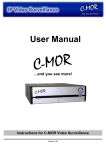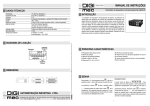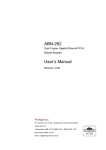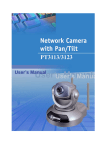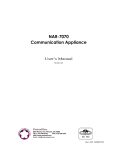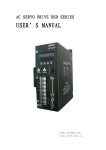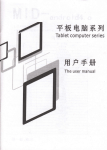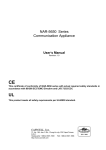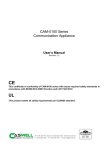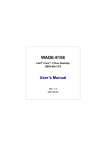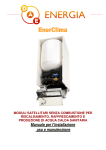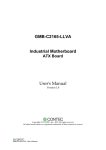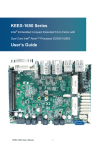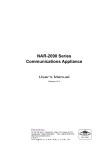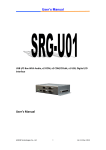Download NAR-7090 User`s Manual V1.2
Transcript
NAR-7090 Series Communication Appliance User′s Manual Revision: 1.4 CE This certificate of conformity of NAR-7090 series with actual required safety standards in accordance with 89/366 ECC-EMC Directive and LVD 73/23 ECC UL This product meets all safety requirements per UL60950 standard. Portwell Inc. 4F, No.186, Jian-Yi RD.,Chung-Ho City, 235 Taipei, Taiwan. Headquarter: +886-2-7731-8888 FAX: +886-2-82271109 http://www.portwell.com.tw Email: [email protected] Table of Contents Chapter 1 Introduction ........................................................................................................... 3 1.1 About This Manual 3 1.2 Manual Organization ......................................................................................................... 3 1.3 Technical Support Information .......................................................................................... 3 1.4 Board Layout..................................................................................................................... 4 1.5 System Block Diagram ...................................................................................................... 5 1.6 Product Specifications ................................................................................................................. 7 1.7 LED Signaling Standard ............................................................................................................... 8 Chapter 2 Getting Started........................................................................................... 10 2.1 Included Hardware .......................................................................................................... 10 2.2 Before You Begin ............................................................................................................ 10 2.3 Hardware Configuration Setting ...................................................................................... 11 2.4 The Chassis .................................................................................................................... 13 2.5 Open the Chassis............................................................................................................ 13 2.6 Install a Different Processor ............................................................................................ 14 2.7 Remove and Install DIMM ............................................................................................... 16 2.8 Remove and Install Compact Flash Card........................................................................ 18 2.9 Remove and Install Battery ............................................................................................. 18 2.10 Install HDD ...................................................................................................................... 19 2.11 Install Riser Card............................................................................................................. 19 2.12 Ear Mount Kit Installation ................................................................................................ 20 2.13 Remove EZIO / LCD ....................................................................................................... 20 2.14 Remove Power Supply.................................................................................................... 22 2.15 Remove main board........................................................................................................ 24 2.16 Use a Client Computer .................................................................................................... 26 Chapter 3 BIOS Setting.......................................................................................... 29 Chapter 4 Programming Guide .................................................................................. 38 4.1 Reset to Default Information ........................................................................................... 38 4.2 Bypass WDT Programming Guide .................................................................................. 43 4.2.1 Bypass State Diagram .................................................................................................................. 44 4.2.2 System flow description: ................................................................................................................ 45 4.3 About EZIO2 ................................................................................................................... 59 4.4 GPIO Sample Code ........................................................................................................ 70 4.5 WDT Sample Code ........................................................................................................ 75 Chapter 5 Appendixes ......................................................................................... 103 NAR-7090 Series User’s Manual 1 5.1 NAR-7090 Ethernet modules configuration................................................................... 103 NAR-7090 Series User’s Manual 2 Chapter 1 Introduction 1.1 About This Manual This manual contains all required information for setting up and using the NAR- 7090 series. NAR-7090 provides the essential platform for delivering optimal performance and functionality in the value communications appliance market segment. This manual should familiarize you with NAR-7090 operations and functions. NAR-7090 series provide up to eight on-board Ethernet ports to serve communication applications like Firewall, requiring ten Ethernet ports to connect external network (internet), demilitarized zone and internal network. NAR-7090 series overview: Supports LG771 Intel 51XX series CPU Up to 32GB ECC/Register FB DIMM 533/667MHz Two USB ports and one RJ45 port on COM1. Four SATA connectors for SATA Hard disk User-friendly LCD control panel PCI-E architecture with totally three PCI-Ex8 interfaces. Provides absolute high flexibility of customized I/O configuration for front accessible PCI-E modules --Maximum twelve PCI-E x4 GbE ports 1.2 Manual Organization This manual describes how to configure your NAR-7090 system to meet various operating requirements. It is divided into three chapters, with each chapter addressing the basic concept and operation of this system. Chapter 1: Introduction. This section describes how this document is organized. It includes brief guidelines and overview to help find necessary information. Chapter 2: Hardware Configuration Setting and Installation. This chapter demonstrated the hardware assembly procedure, including detailed information. It shows the definitions and locations of Jumpers and Connectors that can be used to configure the system. Chapter 3: Operation Information. This section provides illustrations and information on the system architecture and how to optimize its performance. Chapter 4: This section describes how to programming software. It includes By-pass; GPIO; EZIO; Factory Default function. Any updates to this manual, would be posted on the web site: http://isc.portwell.com.tw 1.3 Technical Support Information Users may find helpful tips or related information on Portwell's web site: http://www.portwell.com.tw A direct contact to Portwell's technical person is also available. For further support, users may also contact Portwell’s headquarter in Taipei or local distributors. NAR-7090 Series User’s Manual 3 Taipei Office Phone Number: +886-2-77318888 1.4 Figure 1-1 NAR-7090 Series User’s Manual Board Layout Board Layout of NAR-7090 M/B 4 1.5 System Block Diagram Figure 1-2 NAR-7090 Basic Block Diagram NAR-7090 Series (Standard model) Sub-Model NAR-7090-1013 NAR-7090-1012 NAR-7090-1017 Barebone # ATO # Slot-A1+B1 8 * Fiber Slot-C1 ATO Option 8* Copper with segment bypass ATO Option Bypass Segment N/A 4 N/A Low profile PCI-X 1 1 1 PCI-E X4 slot or 64bit PCI-X Slot Optional HDD Standard 1* 3.5” HDD tray LCM EZIO-3 USB 2 Console RJ45 on COM1 ATO-Options CPU, FBDIMM HDD (SATA) NAR-7090 Series User’s Manual 4 4* Fiber + 4* Copper ATO Option 5 Figure 1-3 NAR-7090 Ethernet Module NAR-7090 Series User’s Manual 6 1.6 # Requirement Product Specifications Detailed Description 1.Processor 1.1 1.2 Supplier CPU Model 1.3 1.4 1.5 Socket Type Front Side Bus Chipset support Intel® Intel® Xeon® 5100 series CPU support list refer to Appendix A LGA 771 1066/1333MHz Intel 5000P (MCH) + 6321 ESB2 (I/O CH) 2.Memory 2.1 2.2 2.3 2.4 Memory Type Memory Slot Maximum Channel ECC/Register FB DIMM 533/667MHz 240pin FBDIMM * 8 Maximum support up to 32GB DIB and Dual channel 3.Expansion Slot 3.1 64-bit PCI-X 3.2 PCI-Express 3.3 PICMG Interface Support 1* 64-bit 133/100MHz PCI-X expansion slots Support 2* 64-bit 133/100MHz PCI-X expansion slots (Option) Not Provide PCI-Express X 1 PCI-Express X 4 Support 1* PCI-E X4 interface from ESB2 on board PCI-Express X 8 Support 3* PCI-E x8 interface in proprietary interface Not Provide 4.I/O port 4.1 4.2 4.3 4.4 IDE channels SATA channels CF slot USB Provide 1* 40 pin IDE connector Provide 4 SATA connectors on board. Support 3Gbps SATA standard Provide 1 CF slot on board Provide 2 USB port on front panel z Support USB 2.0. z USB shall support for FDD, KBD, MOUSE, CD-ROM. z CD-ROM and FDD shall be bootable devices 5. I/O Port 5.1 EIA/TIA232 COM-1 connected as an external accessible RJ-45 connector. Pin-definition refers to Appendix-A. System ship with console cable. 6 Ethernet 6.1 Gigabit Ethernet 6.2 6.3 6.4 10G Ethernet Management Ethernet Function 6.5 Direction Standard model will support 1>. 8 Gigabit Ethernet copper 2>. 8 Gigabit Ethernet ports with 4 copper and 4 SFP connector Not provide on board, but with module support Provide 2* Gigabit Ethernet port as management function Bypass Bypass function as model selection Dual Personality Dual Personality as Module option selection Ethernet interface sequence in Linux OS should be in ascending order from left hand sites. 7. Video 7.1 7.2 EZIO-3 LED Provide 2*16 character LCD display 1 * Power LED (Green) – in front 8. Power supply 8.1 Output Power 8.2 Power on/off operation 8.3 I2C function Provide 2 kind of power supply with active PFC control 1>. 400~460W redundant power supply 2>. 400~460W single power supply z There should be a on/off switch on PSU itself or a separated on/off switch attached to PSU to turn the PSU on/off; this switch is for AT mode operation z There should be a separated toggle switch which is for ATX mode operation z There is an “always on” item in the BIOS. System will be powered up automatically while power is resumed, if it is “on” before power failed z ACPI signal in Linux will be generated while Toggle switch being pressed z Customer can use a script file to specify the power off procedure Provide I2C function for system monitor P/S status 9. System Function 9.1 H/W Reset and Load Factory NAR-7090 Series User’s Manual Provide a reset button in system panel Provide a pin-header on board connect to additional push button for F/D 7 # Requirement Detailed Description Default buttons 9.2 9.3 9.4 9.5 GPIO function Fan connector Flash ROM Non-volatile Memory 9.6 9.7 System Monitoring Feature Watch Dog Timer 9.8 IPMI function (Load Factory Default). The F/D can be connected to a toggle switch and the status of button pressing will be latched by h/w. The button pressing status can be read and cleared by s/w command. Provide easy accessible Hot-Swap fan. 8 M bits z One non-volatile memory is needed via I2C channel. z 8KB memory should be a standard size and it is upgradeable to 64KB. Provide system monitor function that can monitor CPU temperature System Temperature and operating voltage. There should be two choices, reset or interrupt subroutine call, while WDT time-out. Provide IPMI 2.0 on socket 10. System dimension 10.1 10.2 Dimension 2U W: 430mm x D: 510mm x H: 88mm z EZIO z USB interface: dual-USB connectors z RS232 interface: RS232 port with RJ45 connector for system console, tab-down, no LED. z Hardware Reset Button z PCI-X slots opening for option z Ethernet interfaces: z LED: System LED: Power, Ethernet LED: For every Ethernet interface there should be LEDs for link status and speed of LAN-ports, which should be built in the connector. For detailed signaling, please refer to Appendix-D LED Signaling. z AC power inlet z Hot-swapped system Fan modules. Front Panel 10.3 Rear Panel 10.4 Chassis Color 10.5 Environmental requirements Standard Pantone Black-C Temperature 5°C to 40°C. Operating 1.7 Humidity 10~90% RH LED Signaling Standard 1. Power and Data-access LED Lettering Symbol Power status PWR HD LED Function Power HD Status LED Data Data Access Access 2. Color Signaling Green Off – No power, system off. On – Power good, system on. Green Off – No power, No HD On – HD good, Have HD. Blue Off – no data access through IDE or SATA channel On – data is in transition through IDE or SATA channel Ethernet LED Label ACT/LINK Color Green Or Others Indication On Off NAR-7090 Series User’s Manual Status 1. The Ethernet port is receiving power. 2. Good linkage between the Ethernet port and its supporting hub. 1. The adapter and switch are not receiving power. 2. No connection between both ends of network cable. 3. The drivers of Ethernet have not been loaded or does not function correctly. 8 SPEED Green Or Others Flashing Yellow On Green On Off ACT/Link LED The adapter is sending or receiving network data. The frequency of the flashes varies with the amount of network traffic. ACT/LNK LED must on then this LED show the operating at 1000 Mbps. If ACT/LINK is off and this function will be disable. ACT/LNK LED must on then this LED show the operating at 100 Mbps. If ACT/LINK is off and this function will be disable. ACT/LNK LED must on then this LED show the operating at 10 Mbps. If ACT/LINK is off and this function will be disable. Speed LED Bypass LED Copper Ethernet Interface ACT/Link Speed LED LED Bypass LED Fiber/SFP Ethernet Interface 3. Bypass LED LED Status green Bypass normal Mode/Status mode NAR-7090 Series User’s Manual red off bypass mode, triggered power off, in normal or bypass by WDT expiring mode which is defined by customer 9 Chapter 2 Getting Started This section describes how the hardware installation and system settings should be done. 2.1 Included Hardware The following hardware is included in package: NAR-7090 Communication Appliance System Board One null serial port cable 2.2 Before You Begin To prevent damage to any system board, it is important to handle it with care. The following measures are generally sufficient to protect your equipment from static electricity discharge: When handling the board, to use a grounded wrist strap designed for static discharge elimination and touch a grounded metal object before removing the board from the antistatic bag. Handle the board by its edges only; do not touch its components, peripheral chips, memory modules or gold contacts. When handling processor chips or memory modules, avoid touching their pins or gold edge fingers. Restore the communications appliance system board and peripherals back into the antistatic bag when they are not in use or not installed in the chassis. Some circuitry on the system board can continue operating even though the power is switched off. Under no circumstances should the Lithium battery cell used to power the real-time clock be allowed to be shorted. The battery cell may heat up under these conditions and present a burn hazard. WARNING! 1. "CAUTION: DANGER OF EXPLOSION IF BATTERY IS INCORRECTLY REPLACED. REPLACE ONLY WITH SAME OR EQUIVALENT TYPE RECOMMENDED BY THE MANUFACTURER. DISCARD USED BATTERIES ACCORDING TO THE MANUFACTURER’S INSTRUCTIONS" 2. This guide is for technically qualified personnel who have experience installing and configuring system boards. Disconnect the system board power supply from its power source before you connect/disconnect cables or install/remove any system board components. Failure to do this can result in personnel injury or equipment damage. 3. Avoid short-circuiting the lithium battery; this can cause it to superheat and cause burns if touched. 4. Do not operate the processor without a thermal solution. Damage to the processor can occur in seconds. 5. Do not block air vents. Minimum 1/2-inch clearance required. NAR-7090 Series User’s Manual 10 2.3 Hardware Configuration Setting 2.3.1 NAR-7090 System Board Jumper In general, jumpers on NAR-7090 system board are used to select options for certain features. Some of the jumpers are configurable for system enhancement. The others are for testing purpose only and should not be altered. To select any option, cover the jumper cap over (Short) or remove (NC) it from the jumper pins according to the following instructions. Here NC stands for “Not Connected”. Location of Jumpers PPAP-3727L ZR2 JP1: CASEOPEN 2 JP2: SM BUS 4 JP3: RTC clear, 1-2:Normal 2-3: Clear JP4: LC4128V CPLD download JP5: GPIO power, 1-2:5V 2-3:3.3V JP6: Watchdog Enable, in: Enable out: Disable JP7: J32 PCI express (SB 0), out: x4 in: x1 JP8: 2-3 FSB1333(default), open FSB1066 JP9 1-2:J1~J3 4pin fan, 2-3: J1~J3 3pin fan(default 2-3) J1: Chassis Fan 3 J2: Chassis Fan 2 J3: Chassis Fan 3 J4: ATX PSU AUX +12V input NAR-7090 Series User’s Manual 11 J5: PCI-x 64bit expansion slot J6: FBD Channel 3 DIMM 1 J7: FBD Channel 3 DIMM 0 J8: FBD Channel 2 DIMM 1 J9: FBD Channel 2 DIMM 0 J10: FBD Channel 1 DIMM 1 J11: FBD Channel 1 DIMM 0 J12: FBD Channel 0 DIMM 1 J13: FBD Channel 0 DIMM 0 J14/J52: CPU 0 (left) FAN J15/J51: CPU 1(right) FAN J16: CF socket J17: BMC socket J18: ATX PSU main connector J19: CASEOPEN 1 J20: IDE connector J21: Over Temperature LED connector J22: IPMB connector J23: LAN 1 J24: XC9536XL_C CPLD download J25: ATX PSU FAN power connector J26: LAN 2 J27: Printer Port Connector J28: LPC debug port J29: Front Panel Control J30: GPIO J31: PS2 Keyboard / Mouse J32: PCI express x4 expansion slot (SB 0) J33: COM 2 J34: SATA 0 J35: SATA2 J36: COM 1 J37: FAN power option J38: Front Fan J39: USB 0/1 J40: USB 2/3 J41: SATA 0 J42: SATA 1 J43: Front Fan J44: Front Fan J45: Front Fan J46: PCI express x8 expansion slot (NB 4/5) J47: PCI express x8 expansion slot (NB 6/7) J48:: PCI express x8 expansion slot (SB 1/2) J49: IPMB J50: LAN LED J29: Front Panel Control 2PWR LED+ 4PWR LED- 6PWR ON- 8PWR ON+ 10LDF- 12LAN LINK+ 14LAN LINK1IDE LED+ 3IDE LED- 5RESET- 7RESET+ 9LDF+ 11LAN ACT+ 13LAN ACT- J30: GPIO 6 IO10 7 IO11 8 IO12 9 IO13 10 POWER 1 IO17 2 IO16 3 IO15 4 IO14 5 GND 7 NP 8 GND 9 KEY VCC 10 KEY CLK 1 MOUSE DATA 2 NP 3 GND 4 MOUSE VCC 5 MOUSE CLK J31: PS/2 KEYBOARD MOUSE 6 KEY DATA J23, J26 LAN 2D1- (RJ45 2) 4D2- (RJ45 6) 6D3- (RJ45 5) 8D4- (RJ45 8) 10 - 1D1+ (RJ45 1) 3D2+ (RJ45 3) 5D3+ (RJ45 4) 7D4+ (RJ45 7) 9GND 21000- (LAN2,J26) 4ACT- (LAN2) 6LINK- (LAN2) 8100- (LAN2) 10 - 11000- (LAN1,J23) 3ACT- (LAN1) 5LINK- (LAN1) 7100- (LAN1) 9GND J50 LAN LED JP9 set to 2,3 Pin. J39/J40: USB 0(1) / USB 2(3) 5 4 3 2 1 10 9 8 7 6 5 SBV0 (+5V) 4 SBD-1 3 SBD+1 2 GND 1 CHASSIS GND 10 CHASSIS GND 9 GND 8 SBD+0 7 SBD-0 6 SBV0 (+5V) NAR-7090 Series User’s Manual 12 2.4 The Chassis The system is integrated in a customized 2U chassis (Fig. 2-1, Fig. 2-2). On the front panel you will find a 4-push-button LCD module (EZIO), two USB ports and a COM port and Ethernet ports. NAR-7090 / NAR-7090 Fig. 2-1 Front view of the chassis Fig. 2-2 Rear view of the chassis 2.5 NAR-7090 Series User’s Manual Open the Chassis 13 1. Loosen the 2 screws of the chassis, three on each side and the rest two on the back, to remove the top lead (Fig. 2-3). Fig. 2-3 Take off screws 2. The top lead (Fig. 2-4) can be removed from the base stand (Fig. 2-5). Fig. 2-4 The top lead Fig. 2-5 The base stand 2.6 Install a Different Processor To install a CPU 1. Local the CPU socket on the motherboard NAR-7090 CPU socket 771 NAR-7090 Series User’s Manual 14 2. Press the load lever with your thumb (A), then move it to left (B) until it is released from the retention tab 3. Lift the load lever in the direction of the arrow to a 135° angle 4. Lift the load plate with your thumb and forefinger to a 100° angle (A), then push the PnP cap from the load plate window to remove (B) 5. Position the CPU over the socket, making sure that the gold triangle is on the bottom-left corner of the socket. The socket alignment key should fit into the CPU notch NAR-7090 Series User’s Manual 15 6. Close the load plate (A), then push the load lever (B) until it snaps into the retention tab Configure Processor Speed The system was designed to self-detect its CPU speed. So it does not require any system adjustment. 2.7 Remove and Install DIMM Follow these steps to upgrade RAM module: 1. Unlock a DIMM socket by pressing the retaining clips outward 2. Align a DIMM on the socket such that the notch on the DIMM matches the break on the socket NAR-7090 Series User’s Manual 16 3. Firmly insert the DIMM into the socket until the retaining clips snap back in place and the DIMM is properly seated Follow these steps to remove a DIMM: 1. Simultaneously press the retaining clips outward to unlock the DIMM NAR-7090 Series User’s Manual 17 2. Remove the DIMM from the socket 2.8 Remove and Install Compact Flash Card 1. Insert the Compact Flash Card (Fig. 2-7) into the CF interface (Fig. 2-8). Fig. 2-6 Compact Flash Card Fig. 2-7 Insert Compact Flash Card into the CF interface The completed installation of Compact Flash Card is shown as Fig. 2-8 Fig. 2-8 Completion of Compact Flash Card 2.9 Remove and Install Battery 1. Press the metal clip back to eject the button battery (Fig. 2-9). 2. Replace it with a new one by pressing the battery with fingertip to restore the battery (Fig. 2-10). Fig. 2-9 Eject the battery NAR-7090 Series User’s Manual Fig. 2-10 Restore the battery 18 2.10 Install HDD The system has an internal drive bay for one 3.5" SATA hard disk drive. If the HDD is not preinstalled, you can install it by yourself. Follow the steps below to install the HDD: 1. Fasten the four screws to lock HDD and bracket together (Fig. 2-11a, 2-11b). Fig. 2-11a A 3.5”SATA HDD and the HDD bracket Fig. 2-11b Fix HDD to the bracket 2. Connect Power cable and HDD cable to NAR-7090RB system board (Fig. 2-12). Fig. 2-12a Connect HDD bracket to NAR-7090 Fig. 2-12b Fix HDD into NAR-7090 system system then push the switch in. 2.11 Install Riser Card The system has an internal riser card to support up to two PCI-X slots. 1. Fasten the six screws to lock riser and bracket together and fix in NAR-7090 (Fig. 2-11a, 211b). Fig. 2-11a A ABR-162 riser card and the bracket NAR-7090 Series User’s Manual Fig. 2-11b Fix riser card to NAR-7090 19 2.12 Ear Mount Kit Installation The NAR-7090 series shipped with 2 ear mount kits. The following is the installation instruction of these ear mounts: 1. Take out the L shape ear mount kits. One ear mount fits on one side of the chassis, 2. Placing the side with four holes agonists the chassis and the side with two holes face outward. (Fig. 2-13) 3. Fasten four screws on each side (Fig. 2-13) Fig.2-13 Fasten the screws to the side 2.13 Remove EZIO / LCD The NAR-7090 series support EZIO modules. The following is the remove instruction of these EZIO/LCD modules: 1. Remove the system front panel first. 2. Remove all cables from EZIO Fig.2-14 Remove the cable from EZIO NAR-7090 Series User’s Manual Fig.2-15 After remove the cable from EZIO 20 3. Remove the screws from chassis. Fig.2-16 Remove the screws from EZIO 4. Remove the screws from EZIO Kit Fig.2-17 Remove the screws from EZIO kit 5. Final remove the EZIO/LCD module. Fig.2-18 Finish NAR-7090 Series User’s Manual 21 2.14 Remove Power Supply The following is the remove step instruction of power supply. 1. Remove following screws from chassis first. Fig.2-19 Remove the screws from rear chassis Fig.2-20 Remove screws from bottom chassis. 2. Remove all power cables from main board and HDD bay. Fig.2-21 Remove power cables from board Fig.2-22 Remove power cables from board Fig.2-23 Remove power switch cables Fig.2-24 Remove HD cables from HD Bay NAR-7090 Series User’s Manual 22 3. Push the power supply inside system then lift up power supply to pull out the power supply. Fig.2-25.1 Push the power supply inside system. Fig.2-25.2 Pull out the power supply. 4. If user need to change power supply modules. Please follow following steps: Fig.2-26.1 Loosen the screw to unlock the power module. NAR-7090 Series User’s Manual Fig.2-26.2 Pull out the power modules. 23 2.15 Remove main board The following is the remove step instruction of main board. 1. Remove all add-on modules or riser card devices from system first Fig.2-27 Remove Front bezel Fig.2-28 Fig.2-29 Remove middle bracket Fig.2-30 Remove riser card. Fig.2-31 Remove Front bracket Fig.2-32 Remove slot B add-on card NAR-7090 Series User’s Manual Remove all add-on modules. 24 2. Remove following items from main board: Cables, CPU cooler, CPU, memory ,CF ,IPMI , System Fan. Fig.2-33 Remove all cables. from board. Fig.2-33.2 Remove all cable from board. Fig.2-34Remove CPU cooler, CPU , memory , CF and IPMI module. Fig.2-35 Remove System Fan 3. After remove above items, and push the PnP cap back to CPU socket. Users can start remove all screws from board. Fig.2-36Remove all screws from main board. NAR-7090 Series User’s Manual 25 4. After remove all screws from board. User can remove main board. Please be genteelly and carefully. Avoid colliding board with chassis bottom sticks. It may damage the main components. Fig.2-37 lift up main board from rear side of system Fig.2-38 Lift the board up for moving. Fig.2-39Remove main board from rear side Fig.2-35 Finish 2.16 Use a Client Computer Connection Using Hyper Terminal If users use a headless NAR-7090 system, which has no mouse/keyboard and VGA output connected to it, the console may be used to communicate with NAR-7090. To access NAR-7090 via the console, Hyper Terminal is one of many choices. Follow the steps below for the setup: Note: Terminal software may need to update for correct console output. 1. Execute HyperTerminal under C:\Program Files\Accessories\HyperTerminal 2. Enter a name to create new dial NAR-7090 Series User’s Manual 26 3. For the connection settings, make it Direct to Com1. 4. Please make the port settings to Baud rate 19200, Parity None, Data bits 8, Stop bits 1 5. Turn on the power of NAR-7090 system, after following screen was shown: NAR-7090 Series User’s Manual 27 6. You can then see the boot up information of NAR-7090. 7. When message “Hit <DEL> if you want to run Setup” appear during POST, after turning on or rebooting the computer, press <Tab> key immediately to enter BIOS setup program. This is the end of this section. If the terminal did not port correctly, please check the previous steps. NAR-7090 Series User’s Manual 28 Chapter 3 BIOS Setting BIOS Setup Information Power on the system, press the <Del> to run BIOS setup. After press the <Delete> key, the main BIOS setup menu displays. You can access the other setup screens from the main BIOS setup menu, such as the Chipset and Power menus. The BIOS setup/utility uses a key-based navigation system called hot keys. Most of the BIOS setup utility hot keys can be used at any time during the setup navigation process. These keys include <F1>, <F10>, <Enter>, <ESC>, <Arrow> keys, and so on. Control Keys Key Function ↑↓Up /Down The Up and Down <Arrow> keys allow you to select a setup item or sub-screen. ÆÅ The Left and Right <Arrow> keys allow you to select a setup screen. For example: Main screen, Advanced screen, Chipset screen, and so on. Left/Right +Plus/ Minus Tab The Plus and Minus <Arrow> keys allow you to change the field value of a particular setup item. For example: Date and Time. The <Tab> key allows you to select setup fields. NAR-7090 Series User’s Manual 29 Main Menu When you first enter the Setup Utility, you will enter the Main setup screen. You can always return to the Main setup screen by selecting the Main tab. There are two Main Setup options. They are described in this section. NAR-7090 Series User’s Manual 30 System Date / Time Use this option to change the system time and date. Highlight System Time or System Date using the <Arrow> keys. Enter new values through the keyboard. Press the <Tab> key or the <Arrow> keys to move between fields. The date must be entered in MM/DD/YY format. The time is entered in HH:MM:SS format. ¾ Advanced BIOS Setup Select the Advanced tab from the setup screen to enter the Advanced BIOS Setup screen. Select any of the items in the left frame of the screen, such as SuperIO Configuration, to go to the sub menu for that item. It will display an Advanced BIOS Setup option by highlighting it using the <Arrow> keys. All Advanced BIOS Setup options are described in this section. The Advanced BIOS Setup screen is shown below. The sub menus are described on the following pages. . ¾ IDE Configuration Setup From the IDE Configuration screen, press <Enter> to access the sub menu. Use the up and down <Arrow> keys to select an item. The settings are described on the following pages. NAR-7090 Series User’s Manual 31 ¾ SUPER IO CONFIGURATION SuperIO Configuration Use this screen to select options for the Super I/O settings. Use the up and down <Arrow> keys to select an item. Use the <Plus> and <Minus> keys to change the value of the selected option. The settings are described on the following pages. The screen is shown below. ¾ REMOTE ACCESS CONFIGURATION Remote Access Configuration Use this screen to select options for the Remote Access Configuration. Use the up and down <Arrow> keys to select an item. Use the <Plus> and <Minus> keys to change the value of the selected option. The settings are described on the following pages. The screen is shown below. NAR-7090 Series User’s Manual 32 Remote Access Disable or enable the BIOS remote access feature here. Serial Port Number Select the serial port to use for console redirection. Set the value for this option to either COM1 or COM2. Serial Port Mode Select the baud rate you want the serial port to use for console redirection. ¾ USB Configuration Use this screen to select options for the USB Configuration. Use the up and down <Arrow> keys to select an item. Use the <Plus> and <Minus> keys to change the value of the selected option. The settings are described on the following pages. The screen is shown below. Legacy USB Support Legacy USB Support refers to the USB mouse and USB keyboard support. Normally if this option is not enabled, any attached USB mouse or USB keyboard will not become available until a USB compatible operating system is fully booted with all USB drivers NAR-7090 Series User’s Manual 33 loaded. When this option is enabled, any attached USB mouse or USB keyboard can control the system even when there is no USB drivers loaded on the system. Set this value to enable or disable the Legacy USB Support. The Optimal and Fail-Safe default setting is Disabled. ¾ CPU Configuration Use this screen to select options for the CPU Configuration. Use the up and down <Arrow> keys to select an item. Use the <Plus> and <Minus> keys to change the value of the selected option. Note: The CPU Configuration setup screen varies depending on the installed processor. ¾ Boot Settings Select the Boot tab from the setup screen to enter the Boot BIOS Setup screen. ¾ BOOT SETTINGS CONFIGURATION SCREEN Boot Settings Configuration Use this screen to select options for the Boot Settings Configuration. Use the up and down <Arrow> keys to select an item. Use the <Plus> and <Minus> keys to change the value of the selected option. The settings are described on the following pages. The NAR-7090 Series User’s Manual 34 screen is shown below. Quick Boot The Optimal and Fail-Safe default setting is Disabled. Quiet Boot Set this value to allow the boot up screen options to be modified between POST messages or OEM logo. The Optimal and Fail-Safe default setting is Enabled. Add-On ROM Display Mode Set this option to display add-on ROM (read-only memory) messages. The Optimal and Fail-Safe default setting is Force BIOS. An example of this is a SCSI BIOS or VGA BIOS. Boot up Num-Lock Set this value to allow the Number Lock setting to be modified during boot up. The Optimal and Fail-Safe default setting is On. PS/2 Mouse Support Set this value to allow the PS/2 mouse support to be adjusted. The Optimal and Fail-Safe default setting is Enabled Interrupt 19 Capture Set this value to allow option ROMs such as network controllers to trap BIOS interrupt 19. ¾ BOOT DEVICE PRIORITY Boot Device Priority Use this screen to specify the order in which the system checks for the device to boot from. To access this screen, select Boot Device Priority on the Boot Setup screen and press <Enter>. The following screen displays: NAR-7090 Series User’s Manual 35 ¾ Exit Menu Select the Exit tab from the setup screen to enter the Exit BIOS Setup screen. Display an Exit BIOS Setup option by highlighting it using the <Arrow> keys. All Exit BIOS Setup options are described in this section. The Exit BIOS Setup screen is shown below. Saving Changes and Exit When completed the system configuration changes, select this option to leave Setup and reboot the computer so the new system configuration parameters can take effect. Select Exit Saving Changes from the Exit menu and press <Enter>. Discarding Changes and Exit Select this option to quit Setup without making any permanent changes to the system configuration. Select Exit Discarding Changes from the Exit menu and press <Enter>. Discard Changes Select Discard Changes from the Exit menu and press <Enter>. NAR-7090 Series User’s Manual 36 Load Optimal Defaults Automatically sets all Setup options to a complete set of default settings when select this option. Select Load Optimal Defaults from the Exit menu and press <Enter>. Load Fail-Safe Defaults Automatically sets all Setup options to a complete set of default settings when yselect this option. The Fail-Safe settings are designed for maximum system stability, but not maximum performance. Select the Fail-Safe Setup options if computer is experiencing system configuration problems. Select Load Fail-Safe Defaults from the Exit menu and press <Enter>. NAR-7090 Series User’s Manual 37 Chapter 4 Programming Guide 4.1 Reset to Default Information // // Portwell Confidential ! // Portwell Intellectual Property, All rights reserved. // //////////////////////////////////////////////////////////////////////////////// // // Program : 3727RSTD.CPP // Descript. : PPAP-3727 Reset to Default test program // Designer : Frank Hsu // Language : Borland C++ 5.02 // O.S. : MS-DOS/Win98 only // Upddate : 11222006 Release // // //////////////////////////////////////////////////////////////////////////////// /* =============================================================================== // ; Reset to default status can be read from ESB2(631x)_ICH_GPI24. ; After Power On reset, GPI24 = low ( 0 ) ; If Reset to Default (RST2DF) Button pressed ( Triggered ) ; ,then GPI24 will be latch to high ( 1 ). ; ; RST2DF register can be cleared by 6300ESB_ICH_GPO18. ; Write a pulse timing ( High1_low_high2 ) to clear RST2DF to 0. ; High1 : output GPO18 high , and retain 15 us. ; Low : output GPO18 low , and retain 15 us. ; High2 : output GPO18 high again , and retain high always. ; ; ; Programming Guide : ; ; ; ; PG_Step1 : Enable GPIO IO function and get GPIOBASE ; ; ; How to program GPIO18 ( Output only , i.e. GPO18 ) ; ------------------------------------------------------; Get GPIOBASE =: B0:D31:F0:Offset[48..4Bh] ;(and let bit0 = 0 ) ; GPIO_CNTL =: B0:D31:F0:Offset_4Ch_bit4P1 ;Enable 631xESB_ICH GPIO ; ; GPIO18 ; GP_LVL (=:(GPIOBASE + 0Ch))_bit18P[0/1]; Write value 0/1 ; -----------------------------------------------------; ; How to read GPI24 ; ====================================================== ; GPI24 status MUST NOT be inverted First. ; GPI_INV (=GPIOBASE+2Ch)-bit24P0. ( GPI24 not inverted ) ; ; Get GPI24 status from GP_LVL (=GPIOBASE + 0Ch)-bit24 ; 0 = low , 1= high level ; ====================================================== =============================================================================== */ NAR-7090 Series User’s Manual 38 #include "stdlib.h" #include "conio.h" #include "stdio.h" #include "dos.h" // for delay(), and sleep() #pragma inline // for inline asm , Need TASM.exe #define GP_LVL_OFFSET 0x0C // The offset value from GPIOBASE #define GPIO_USE_SEL_OFFSET 0x00 // offset from GPIOBASE ( Bit19P1 to define GPIO19) #define GPO_BLINK_OFFSET 0x18 // Offset from GPIOBASE ( Bit19P0 , no blink ) #define GPO18_BYTE_CONVERT 0x02 // Convert Bit18 to ( GP_LVL+OFFSET + 02 ) for byte access #define GPI24_BYTE_CONVERT 0x03 // Convert Bit18 to ( GP_LVL+OFFSET + 02 ) for byte access #define PCR_ADDR #define PCR_DATA #define OR_BIT2 #define AND0_BIT2 0x0CF8 0x0CFC // IO port CF8h for PCI config R/W // IO port CFCh for PCI config R/W 0x04 // Bit2P1 0xFB // Bit2P0 #define GPIOBASE_PCR_OFFSET 0x8000F848 // B0:D31:F0:Offset_48h #define GPIOBASE_CNTL_PCR_OFFSET 0x8000F84C // B0:D31:F0:Offset_4Ch , bit4P1 to enable GPIO #define IGNORE_BIT2T0 0xFFFFFFF8 // Ignore Bit[2:0] for IO BAR #define MASK_BIT4_P1 0x00000010 // Mask bit4 and write 1 #define portb 0x61 #define refresh_status 0x10 // Global Variable unsigned int GPIOBASE ; void IO_delay() { inportb(0x80) ; inportb(0x80) ; } unsigned long inportd(unsigned short p) { asm mov dx, p; asm in eax,dx ; return _EAX; } // end of inportd void outportd(unsigned short p, unsigned long v) { asm mov dx, p; asm mov eax,v; asm out dx,eax; } // end of outportd void fixdelay_15us () { // delay 15 us unsigned char char_ah,char_al ; char_ah = inportb ( portb ) & refresh_status ; fixdelay_loop : char_al = inportb ( portb ) & refresh_status ; if(char_ah == char_al ) goto fixdelay_loop ; } // end of fixdelay_15us void display_menu() { NAR-7090 Series User’s Manual 39 printf("\nPORTWELL PPAP-3727,3727RSTD.exe, V1.00 11-22-2006,All rights reserved.\n\n") ; printf(" For PPAP-3727 Reset-to-Default test \n\n") ; printf(" This status bit = 0 ---> Normal. \n") ; printf(" This status bit = 1 ---> RST2DF button has been pressed.\n") ; printf(" This status bit can be read by 631xESB_ICH_GPI24, \n"); printf(" and can be cleared by an ICH_GPO18 High1-Low-High2 pulse.\n"); printf(" High1 = 30us High level \n"); printf(" Low = 30us Low level \n"); printf(" High2 = High level again and no level change from now on.\n"); } // end of display_menu() void GPO18_HLH() { unsigned char al_char ; al_char = inportb( GPIOBASE + GP_LVL_OFFSET + GPO18_BYTE_CONVERT ) | OR_BIT2 ; // Bit2 P1 outportb ( GPIOBASE + GP_LVL_OFFSET + GPO18_BYTE_CONVERT , al_char ) ; // output GPO18 1 fixdelay_15us () ; fixdelay_15us () ; al_char = al_char & AND0_BIT2 ; outportb ( GPIOBASE + GP_LVL_OFFSET + GPO18_BYTE_CONVERT , al_char ) ; // output GPO18 0 fixdelay_15us () ; fixdelay_15us () ; al_char = al_char | OR_BIT2 ; // Bit2 P1 outportb ( GPIOBASE + GP_LVL_OFFSET + GPO18_BYTE_CONVERT , al_char ) ; // output GPO18 1 fixdelay_15us() ; fixdelay_15us() ; } // end of GPO18_HLH() unsigned int main () { unsigned char al_char , al_ch , al_error =0x00 ; unsigned int j; unsigned long int i_EAX ; display_menu() ; // ---outportd(PCR_ADDR, GPIOBASE_CNTL_PCR_OFFSET ) ; // Enable GPIO i_EAX = inportd(PCR_DATA) | MASK_BIT4_P1 ; // Bit4P1 to enable GPIO outportd(PCR_ADDR, GPIOBASE_CNTL_PCR_OFFSET ) ; outportd(PCR_DATA, i_EAX ) ; outportd(PCR_ADDR, GPIOBASE_PCR_OFFSET ) ; // Get GPIOBASE GPIOBASE = inportd(PCR_DATA) & IGNORE_BIT2T0 ; // Truncate high word // --// Define GPIO function for GPIO18 pin. al_char = inportb( GPIOBASE + GPIO_USE_SEL_OFFSET + GPO18_BYTE_CONVERT ) | OR_BIT2 ; outportb ( GPIOBASE + GPIO_USE_SEL_OFFSET + GPO18_BYTE_CONVERT , al_char ) ; // ============================ MUST DO ==========================Start // Define GPO18 as non blinking NAR-7090 Series User’s Manual 40 al_char = inportb( GPIOBASE + GPO_BLINK_OFFSET + GPO18_BYTE_CONVERT ) & AND0_BIT2 ; outportb ( GPIOBASE + GPO_BLINK_OFFSET + GPO18_BYTE_CONVERT , al_char ) ; // ============================ MUST DO ==========================End /* ; Testing way : ; --- t1 ; Read GPI24 first , GPI24=0 ? if yes,pass ; if no, failed ; ; --- t2 ; RST2DF button pressed and released , read GPI24 ,GPI24 = 1 ? if yes, pass ; if no, failed ; ; --- t3 ; Clear RST2DF status to 0 ,read GPI24 ,GPI24 = 0 ? if yes, pass ; if no, failed ;------------------------------------------------------------------ t_start */ al_char = inportb( GPIOBASE + GP_LVL_OFFSET + GPO18_BYTE_CONVERT ) | OR_BIT2 ; // Bit2 P1 outportb ( GPIOBASE + GP_LVL_OFFSET + GPO18_BYTE_CONVERT , al_char ) ; // output GPO18 1 first fixdelay_15us () ; al_char = inportb( GPIOBASE + GP_LVL_OFFSET + GPI24_BYTE_CONVERT ) & 0x01 ; if(al_char != 0x00) { // Wrong initial status printf("\n Error#01:\"Reset-to-Default F/F Initialization\" Failed. ***** \n") ; printf(" \( This may be a H/W error or Reset-to-Default button has ever been pressed ! \) \n"); al_error = al_error | 0x01 ; printf("\n\n Press \"Q\" key to stop test and return to DOS; or other key to go on next test") ; j = getche() ; al_ch = j ; // Truncate high byte if ( ( al_ch == 'Q' ) || (al_ch == 'q' ) ) goto test1_failed ; } // end_test1 : printf("\n Press the Reset-to-Default button and then release it for the test NOW!\n"); printf("\n Ready ? If yes , then Press any key to start test ....... ") ; getche() ; al_char = inportb( GPIOBASE + GP_LVL_OFFSET + GPI24_BYTE_CONVERT ) & 0x01 ; if( al_char != 0x01 ) { // Wrong reset to default printf("\n Error#02:\"Reset-to-Default event latched by F/F \" Failed. ***** \n") ; al_error = al_error | 0x02 ; printf("\n\n Press \"Q\" key to stop test and return to DOS; or other key to go on next test") ; j = getche() ; al_ch = j ; // Truncate high byte if ( ( al_ch == 'Q' ) || (al_ch == 'q' ) ) goto test_failed ; } // end_test2 GPO18_HLH() ; al_char = inportb( GPIOBASE + GP_LVL_OFFSET + GPI24_BYTE_CONVERT ) & 0x01 ; if ( al_char != 0x00 ) { // Wrong status after GPO18 H_L_H command printf("\n Error#03:\"Clear Reset-to-Default F/F status \" Failed. ***** \n") ; al_error = al_error | 0x04 ; NAR-7090 Series User’s Manual 41 } if(al_error != 0x00 ) goto test_failed ; printf("\n\n <<..... PPAP-3727 RESET-TO-DEFAULT test OK ..^_^...>> \n\n") ; exit(0) ; test1_failed : GPO18_HLH() ; // Init F/F to 0 ( Normal state ) printf("\n\n <<***** PPAP-3727 RESET-TO-DEFAULT test FAIL *****>> ,error=0x%2X\n",al_error) ; exit(1) ; test_failed : printf("\n\n <<***** PPAP-3727 RESET-TO-DEFAULT test FAIL *****>> ,error=0x%2X\n",al_error) ; exit(1) ; } // end of main NAR-7090 Series User’s Manual 42 4.2 Bypass WDT Programming Guide ABN-478 bypass and BYPASS Programming Guide. 0. Release note: ………………………………………………………………………44 1. Bypass State Diagram ...................................................................................... 2. System flow description: ..............................................................................45 2-1. System status diagram .............................................................................................45 2-2. Mode change diagram..............................................................................................46 2-3. Non-normal mode diagram........................................................................47 2.4 Next boot setting Diagram .........................................................................................48 2.5 Watch dog timer Diagram ..........................................................................................49 3. Environment: ………………………………………………………………………49 4. Check software component..........................................................................49 5. Setup sequence:............................................................................................50 5-1. Make execute file to test...........................................................................................50 6. Test program description .............................................................................50 7. API description ..............................................................................................51 7-1 dev_found …………………………………………………………………………………..51 7-2. set_to_normal ……………………………………………………………………………51 7-3. set_to_nonormal……….. ..........................................................................................51 7-4. set_nextboot…………...............................................................................................52 7-5. set_bpe……………… ...............................................................................................52 7-6 set_period_wdt………. ..............................................................................................53 7-7. arm_wd……………… ...............................................................................................53 7-8. dis_arm_wdt_to_sts… ..............................................................................................54 7-9. dis_bp_wdt…………. ................................................................................................55 7-10 read_status_now…..................................................................................................55 7-11 read_settint_wdt…… ...............................................................................................56 7-12 read_mode_nb……. ......................................................................... ……………….56 7-13 read_mode_pfwdte…. .............................................................................................57 7-14 scenario_go……….. ................................................................................................57 7-15 bypass_proc_step…................................................................................................58 NAR-7090 Series User’s Manual 43 4.2.0 Release note: Version Date Description Author 1.00 2007/3/9 Release origin version. Angus Yang PCI-E Bus PCI-E X4 PCI-E X4 82571EB U5 82571EB U6 82571EB U7 82571EB U8 J4 J6 J8 J10 J5 J7 J9 J11 Normal Mode Non-Normal Mode Figure 0 ABN-478 Block Diagram 4.2.1 Bypass State Diagram A B A B A B A’ B’ A’ B’ A’ B’ Normal mode Bypass mode / Non-normal mode Figure 1 NAR-7090 Series User’s Manual Open mode / Non-normal mode 44 4.2.2 System flow description: 4.2.2-1. System status diagram When power start up, system will go into normal mode or non-normal mode as Figure 2-1. System start diagram System start Non-normal mode status=0x01 or 0x02 Normal mode status=0x00 status=0x00 (normal mode) status=0x01 (open mode) status=0x02 (bypass mode) Figure 2-1. When system starts, it will go into normal mode or non-normal mode. Which mode system will go into, it depends on the set by API set_nextboot (please refer to chapter 4.2.7-4) NAR-7090 Series User’s Manual 45 4.2.2-2. Mode change diagram Mode can be changed by software, its status flow as figure 2-2 descript Mode change Diagram change to Non-normal mode Normal mode status=0x00 Non-normal mode status=0x01 or 0x02 change to normal mode status= 0x00 (normal mode) status= 0x01 (open mode) status= 0x02 (bypass mode) Figure 2-2 Mode is changed to Non-normal mode by API set_to_non-normal (refer to chapter 4.2.7-3), And it can be changed to normal mode by API set_to_normal (refer to chapter 4.2.7-2). About status descript as below: 0x00,its mean is normal mode, 0x01,its mean is open mode. 0x02, its mean is bypass mode. NAR-7090 Series User’s Manual 46 4.2.2-3. Non-normal mode diagram About non-normal mode, it includes two parts, one is open mode, and another is bypass mode. The detail description as below Non-normal mode Diagram change to bypass mode Open mode status=0x01 Bypass Mode status=0x02 change to open mode status= 0x01 (open mode) status= 0x02 (bypass mode) Figure-2.3 In non-normal mode. Mode can be changed to open mode or bypass mode. They can be set by API set _bpe (refer to chapter 4.2.7-5). If user wants to assign system to open mode, send command set_bpe as SET_BPE_OPEN, assign system to bypass mode, send command set_bpe as SET_BPE_BYPASS. NAR-7090 Series User’s Manual 47 4.2.2-4 Next boot setting Diagram About next boot setting, it descript as below (to see figure 2-4) Next boot setting diagram change to Non-normal mode Normal mode status=0x00 Non-normal mode status=0x01 or 0x02 change to Normal mode status=0x00 (normal mode) status=0x01 (open mode) status=0x02 (bypass mode) Figure 2-4 User can assign system be in normal mode or non-normal when system start up. Set it by API set_nextboot (refer to chapter 4.2.7-4). If user wants to assign system to normal mode, set set_nextboot as SET_NB_NORMAL. If user wants to assign system to non-normal mode, set set_nextboot as SET_NB_NON_NORMAL. NAR-7090 Series User’s Manual 48 4.2.2-5 Watch dog timer Diagram About Watch dog timer status, the detail descript as below ARM_Watch dog timer Diagram arm watch dog timer Normal mode status=0x00 or Non-normal mode status=0x01 or 0x02 Normal mode status=0x00 watch dog timer is not expired Non-Normal mode status=0x01 or 0x02 watch dog timer is expired status= 0x00 (normal mode) status= 0x01 (open mode) status= 0x02 (bypass mode) Figure 2-5 When watch dog timer is armed, system will be in normal mode, and waiting for watch dog timer expiring, after watch dog timer expire, system will be in non-normal mode. User can set it by API arm_wdt (refer to chapter 4.2.7-7) 4.2.3. Environment: We build and test programs base on gcc version 4.1.0 20060304 (Fedora Core 5). And gcc version 3.2.2 20030222(red-hat 9) 4.2.4. Check software component z z . /lib/portwell_bypass.a Test program (. /ap/) It includes such test program as below://v1.01 NAR-7090 Series User’s Manual 49 test_all.c set_normal.c set_nonormal.c test_long_api.c test_nb_nonormal_mode.c test_nb_normal_mode.c test_pfwdte_bypass.c test_pfwdte_open.c test_period_wdt_1.c test_period_wdt_2.c test_period_wdt_1691252.c test_period_wdt_2114065.c *note: all functions are all for single card test,it does not support more cards test at the same time now. 4.2.5. Setup sequence: 4.2.5-1. Make execute file to test Please go into abn478 path, and then do ./compile.sh command to build execute file to test. 4.2.6. Test program description item Function name Description 1 test_all.c Test all functions as above description 2 Set_normal.c Change mode to normal 3 Set_nonormal.c Change mode to open 4 test_pfwdte_open.c Set to open mode when power off 5 test_pfwdte_bypass.c Set to bypass mode when power off 6 test_nb_normal_mode.c Set system to normal mode when next boot. 7 test_nb_nonormal_mode.c Set system to non-normal mode when next boot. 8 test_period_wdt_1.c set watch dog timer period as 1 sec 9 test_period_wdt_2.c set watch dog timer period as 2 sec 10 test_period_wdt_3.c set watch dog timer period as 3 sec 11 test_period_wdt_4c set watch dog timer period as 4 sec NAR-7090 Series User’s Manual 50 4.2.7. API description 4.2.7-1 dev_found Function name dev_found Description To find the NIC device Format: int dev_found(unsigned char prod_num) Input: prod_num 1-1. PROD_ABN478: bypass card of abn478 Return: 0: device was found successfully -1:can not find device. 4.2.7-2. set_to_normal Function name set_to_normal Description Set Ethernet segment to normal mode Format: unsigned char set_to_normal(unsigned char mode,unsigned char seg,unsigned char proc_dev) Input: 1. mode:0x00 ignore. 2. seg: 1:segement 1. 2:segement 2. 3:segement 3. 4:segement 4. 3. proc_dev: 3-1. PROD_ABN478: bypass card of abn478 Return: 0: return ok. -1:return fail. 4.2.7-3. set_to_nonormal Function name set_to_nonormal Description Set Ethernet segment to non-normal mode Format: unsigned char set_to_nonormal(unsigned char mode,unsigned char seg,unsigned char proc_dev) Input: 1. mode:0x00 ignore. 2. seg: 1:segement 1. 2:segement 2. 3:segement 3. 4:segement 4. 3. proc_dev: 3-1. PROD_ABN478: bypass card of abn478 Return: 0: return ok. NAR-7090 Series User’s Manual 51 -1:return fail. 4.2.7-4. set_nextboot Function name set_nextboot Description 1. Set Ethernet segment to normal mode or non-normal mode when boot up next time Format: unsigned char set_nextboot(unsigned char mode,unsigned char seg,unsigned char proc_dev) Input: 1. mode: SET_NB_NORMAL : normal when next boot up. SET_NB_NON_NORMAL:non_normal when next boot up 2. seg: 1:segement 1. 2:segement 2. 3:segement 3. 4:segement 4. 3. proc_dev: 3-1. PROD_ABN478: bypass card of abn478 Return: 0: return ok. -1:return fail. 4.2.7-5. set_bpe Function name set_bpe Description Set Ethernet segment to open mode or bypass mode when power fails or NAR-7090 Series User’s Manual 52 watch dog timer expires Format: unsigned char set_bpe(unsigned char mode,unsigned char seg,unsigned char proc_dev) Input: 1. mode: SET_BPE_OPEN: set Ethernet port to open mode. SET_BPE_BYPASS: set Ethernet port to bypass mode. 2. seg: 1:segement 1. 2:segement 2. 3:segement 3. 4:segement 4. 3. proc_dev: 3-1. PROD_ABN478: bypass card of abn478 Return: 0: return ok. -1:return fail. 4.2.7-6 set_period_wdt Function name set_period_wdt Description Set watch dog timer period Format: int set_period_wdt (unsigned char pd,unsigned char seg,unsigned char proc_dev)//v1.04 Input: 1. pd 1:set watch dog timer period as 1s 2:set watch dog timer period as 2s 3:set watch dog timer period as 3s 4:set watch dog timer period as 4s (Abn478 supports watch dog timer count from 1 to 63 seconds) 1. seg: 1:segement 1. 2:segement 2. 3:segement 3. 4:segement 4. 2. proc_dev: 3-1. PROD_ABN478: bypass card of abn478 Return: 0: return ok. -1:return fail. 4.2.7-7. arm_wd NAR-7090 Series User’s Manual 53 Function name arm_wdt Description Test mode changing rate by watchdog timer, and its period is set by set_period_wdt function (6-6). Its mode will be changed to bypass-mode when watchdog timer time out. Format: unsigned char arm_wdt(unsigned char mode,unsigned char seg,unsigned char proc_dev) Input: 1. mode: 0x00 ignore 2. seg: 1:segement 1. 2:segement 2. 3:segement 3. 4:segement 4. 3. proc_dev: 3-1. PROD_ABN478: bypass card of abn478 Return: 0: return ok. -1:return fail. 4.2.7-8. dis_arm_wdt_to_sts Function name Dis_arm_wdt_to_sts Description Clear the set of watchdog timer. Format: unsigned char dis_arm_wdt_to_sts(unsigned char mode,unsigned char seg,unsigned char proc_dev) Input: 1. mode: 0x00 ignore 2. seg: 1:segement 1. 2:segement 2. 3:segement 3. 4:segement 4. 3. proc_dev: 3-1. PROD_ABN478: bypass card of abn478 Return: 0: return ok. -1:return fail. NAR-7090 Series User’s Manual 54 4.2.7-9. dis_bp_wdt Function name dis_bp_wdt Description Disable watch dog timer and keep status as current state Format: 1. If Ethernet is on bypass mode, when user does this command, it will be disable watch dog and keep it in bypass mode. If normal mode, after doing this command, it will be kept in normal mode. unsigned char dis_bp_wdt(unsigned char mode,unsigned char seg,unsigned char proc_dev) Input: 1. mode: 0x00 ignore 2. seg: 1:segement 1. 2:segement 2. 3:segement 3. 4:segement 4. 3. proc_dev: 3-1. PROD_ABN478: bypass card of abn478 Return: 0: return ok. -1:return fail. 4.2.7-10 read_status_now Function name read_status_now Description Read bypass status Format: unsigned char read_status_now(unsigned char mode,unsigned char seg,unsigned char proc_dev) Input: 1. mode: 0x00 ignore 2. seg: 1:segement 1. 2:segement 2. 3:segement 3. 4:segement 4. 3. proc_dev: 3-1. PROD_ABN478: bypass card of abn478 Return: 0: normal mode. 1: open mode 2:bypass mode NAR-7090 Series User’s Manual 55 4.2.7-11 read_settint_wdt Function name read_setting_wdt Description Read watch dog timer setting Format: unsigned char read_setting_wdt(unsigned char mode,unsigned char seg,unsigned char proc_dev) Input: 1. mode: 0x00 ignore 2. seg: 1:segement 1. 2:segement 2. 3:segement 3. 4:segement 4. 3. proc_dev: 3-1. PROD_ABN478: bypass card of abn478 Return: 0: ok. 1: fail. 0xff:device fail. 4.2.7-12 read_mode_nb Function name read_mode_nb Description Read next boot status Format: unsigned char read_mode_nb(unsigned char mode,unsigned char seg,unsigned char proc_dev) Input: 1. mode: 0x00 ignore 2. seg: 1:segement 1. 2:segement 2. 3:segement 3. 4:segement 4. 3. proc_dev: 3-1. PROD_ABN478: bypass card of abn478 Return: 0: next boot=normal mode. 1: next boot=non-normal mode & BPE=open mode. 2: next boot=non-normal mode & BPE=bypass mode. NAR-7090 Series User’s Manual 56 4.2.7-13 read_mode_pfwdte Function name read_mode_pfwdte Description Read bpe status Format: unsigned char read_mode_pfwdte(unsigned char mode,unsigned char seg,unsigned char proc_dev) Input: 1. mode: 0x00 ignore 2. seg: 1:segement 1. 2:segement 2. 3:segement 3. 4:segement 4. 3. proc_dev: 3-1. PROD_ABN478: bypass card of abn478 Return: 1: pfwdte to open mode. 2: pfwdte to bypass mode. 4.2.7-14 scenario_go Function name scenario_go Description Go abn478 bypass module all functions automatically. Format: unsigned char scenario_go(unsigned int rst[][DO_FUNCTION_NUM],unsigned char prod_type) Input: 1. rst: array of return code. 0:normal mode. 1:open mode. 2:bypass mode. 2. prod_type: 2-1. PROD_ABN478: bypass card of abn478 DO_FUNCTION_NUM:0x0c.(it has 12 functions to test) Return: 0:ok 1:fail. NAR-7090 Series User’s Manual 57 4.2.7-15 bypass_proc_step Function name bypass_proc_step Description Run abn478 bypass function Format: unsigned char bypass_proc_step(unsigned char dowhat,unsigned char *rst,unsigned char prod_type,unsigned char para_var)Input: 1. dowhat: DO_SET_NORMAL: do normal mode function DO_SET_NONNORMAL:do non_normal mode function DO_SET_NEXTBOOT_NONNORMAL:do next boot non_normal mode function. DO_SET_NEXTBOOT_NORMAL:do next boot normal mode function DO_SET_BPE_OPEN:record bpe mode to open DO_SET_BPE_OPEN_RUNTIME:change bpe mode to open mode(relay will action) DO_SET_BPE_BYPASS:record bpe mode to bypass mode. DO_SET_BPE_BYPASS_RUNTIME:change bpe mode to bypass mode(relay will action) DO_SET_WDT_PERIOD:set watch dog timer period. DO_SET_WDT_DIS_BP: disable watch dog timer. DO_SET_WDT_DIS_ARM: Clear the set of watchdog timer. DO_SET_WDT_ARM:do watch dog timer expire function. 2. *rst array of return code. 2-1. 0:normal mode. 2-2. 1:open mode. 2-3. 2:bypass mode. 3. prod_type: 3-1. PROD_ABN478: bypass card of abn478 DO_FUNCTION_NUM:0x0c.(it has 12 functions to test) Return: 0:ok 1:fail. NAR-7090 Series User’s Manual 58 4.3 About EZIO2 Proprietary keypad and LCD display interfaces are implemented in traditional computing system design, but they are usually different from system to system. The main purpose to roll this module out is to provide an easier human-machine interface for those computing systems regarding application friendly operation as a “must.” The design goals of this interface are: A single interface for those applications where both LCD display and keypad are required. This interface should be available in every computing system. The communication implementation should be OS independent. Our solution is to use “Serial port” as the interface for both LCD display and keypad. A simple protocol is further defined so that applications can directly communicate with this module no matter what the Operating System is. WARNING! THE LCD DRIVER ICS ARE MADE OF CMOS PROCESS, DAMAGED BY STATIC CHARGE VERY EASILY. MAKE SURE THE USER IS GROUNDED WHEN HANDLING THE LCD. 4.3.1 Features • • • • • • • Ideal user interface for communication appliance No driver required; OS independent Alphanumeric characters display support Four key pads can be customized for different applications Easy system installation and operation Clearly display system status Single interface to SBC or M/B 4.3.2 Technical Support Information For further support, users may also contact Portwell’s headquarter in Taipei or your local distributors. Taipei Office Phone Number: +886-2-27992020 NAR-7090 Series User’s Manual 59 4.3.3 Mechanical Specification Module Size (mm): • 101.6(W) x 26.0(H) x 30.6(D) (max.) Display Format: • 16 characters x 2 lines Character Size: • 3.0 x 5.23 mm 4.3.4 General Specification General Specification Display Resolution: • 16 characters x 2 lines Dimensional Outline (mm): • 101.6(W) x 26.0(H) x 30.6(D) (max.) Function Key: • Four operation keys (up, down, enter and ESC) Display Icon: • Eight self-defined icons Interface: • RS-232 Absolute Maximum Rating Normal Temperature Item Ambient Temperature Humidity (w/o condensation) Operating Storage Max. Min. Max. Min. 0ºC +45ºC -20ºC +70ºC Note 2, 4 Note 3, 5 4.3.5 Product Outlook NAR-7090 Series User’s Manual 60 4.3.6 Interface Pin Assignment There are only two connectors in this module, as shown in Figure C.2-1: power connector and Serial Port connector. The power source into this module is 5 volt only. There are only three pins used in the Serial Port interface (Figure C.2-2). Serial Port Connector Power Connector 5 10 4 9 3 8 2 7 1 6 Pin 2: TxD Pin 3 : RxD Pin 5 : Ground Fig. C.2-1 Power connector and serial port connector of EZIO-100 Fig. C.2-2 Pin assignment In other words, the Serial Port is defined as DCE. Therefore, we can use a straight-through cable to connect it to the Serial Port of most of the computers, defined as DTE. (1) Interface Pin Assignment PIN NO. PIN OUT Description 1 NC No connector 2 RXD RS232 Data 3 TXD RS232 Data 4 NC No connector 5 VSS Ground 6 NC No connector 7 NC No connector 8 NC No connector 9 NC No connector 9 NC No connector (2) Power PIN NO. PIN OUT 1 NC 2 GND Power GND 3 GND Power GND 4 +5V Power VCC (+5V) NAR-7090 Series User’s Manual Description No connector 61 4.3.7 Hardware installation The installation steps are: Connect the power connector to the power connector of this module. Connect the straight-through cable between Serial Port of this module and computer 4.3.8 EZIO2 Function Command First, all versions (00A, 01A, 02A) of EZIO can use those commands. Only the 02A version of EZIO firmware that adds “FE 28” & “FE 37” command can control start of HEX & End of HEX. EZIO is an intelligent device, which will display those data received from RS-232 port and reply key pressing status to polling command from RS-232 port. Both commands and data go thru RS-232 ports. To distinguish between data and commands, the LCD/key-pad module recognizes a command prefix, 254 (Hex 0FE). The byte following “254” will be processed as a command. For example, to clear the screen, send the command prefix (254) followed by the LCD clear-screen code (1). The valid data range is shown as the following table: Valid data range Displayed characters 0-7 Customized icon 0-7 48-57 (30-39 Hex) 0-9 65-90 (41-5A Hex) A-Z 97-122 (61-7A Hex) a-z To get the key pressing status, a “read key” command can be issued to this module, which will check the key-pressing status and reply accordingly. The following are the commands and corresponding Decimal/Hex values: Functions/commands Decimal/Hex Comment 1. Start Of HEX 40/28 Only for 02A 2. End Of HEX 55/37 Only for 02A 3. Clear screen 1/01 4. Home cursor 2/02 5. Read key 6/06 6. Blank display (retaining data) 8/08 7. Hide cursor & display blanked characters 12/0C 8. Turn on (blinking block cursor) 13/0D 9. Show underline cursor 14/0E 10. Move cursor 1 character left 16/10 11. Move cursor 1 character right 20/14 12. Scroll 1 character left 24/18 13. Scroll 1 character right 28/1C 14. Set display address (position the cursor) location 128 (Hex080)+ Location See note 2 15. Set character-generator address 64 (Hex 040)+ address See note 3 NAR-7090 Series User’s Manual See note 1 62 Note 1: Upon receiving the “read key” command from host computer, the LCD/keypad module will check the status of every key and reply with status command accordingly. The replied message from LCD/key-pad module consists of a header and a status byte. The header byte is 253 (Hex0FD). The high nibble (with the most significant bit) of the status byte is always “4” and the low nibble (with the least significant bit) of the status byte is used to indicate key pressing status of the keypad module. This nibble will be “F” (of four 1s), if no key pressed while the “read key” received. “0” will be used to indicate key pressing status of corresponding key. There are four keys in this module – upper arrow, down arrow, enter (ENT), and escape (ESC). The relationship between the function key, corresponding status bit and status byte is shown as the table below. Function key Corresponding status bit Status byte Escape The fourth bit of lower nibble (the least significant bit) (1110) B7 (H) Up arrow The third bit of lower nibble (1101) BE (H) Enter The second bit of lower nibble (1011) BB (H) Down arrow The first bit of lower nibble (0111) BD (H) More than one key can be pressed at the same time so that there may be more than one “0”s in the low nibble of status byte. For example, if Up and Down arrow keys are pressed at the same time while “read key” command received, the replied status will be “Hex045”. Note 2: This command can be used to place the cursor at any location. The corresponding address for each character on the screen is as follows: For 16×2 Display Address Character 1 2 3 4 5 6 7 8 9 10 11 12 13 14 15 16 Location (Address) 00 40 01 41 02 42 03 43 04 44 05 45 06 46 07 47 08 48 09 49 0A 4A 0B 4B 0C 4C 0D 4D 0E 4E 0F 4F The addresses of characters at the same row are continuous, so moving cursor commands can be applied to shift the cursor position back and forth. However, the addresses of characters between upper and lower row are discontinuous. To change cursor position between upper row and lower row, this command will be applied. Note 3: This command can be used to create customized icon. The starting address is 64 and every character will take 8 bytes to create a 5(W) x 7(H) resolution picture, as shown below: CG RAM MAPPING CG RAM Address 5 4 High 0 0 0 0 3 0 1 NAR-7090 Series User’s Manual 2 0 0 0 0 1 1 1 1 0 0 0 0 1 1 1 1 1 0 Low 0 0 0 1 1 0 1 1 0 0 0 1 1 0 1 1 0 0 0 1 1 0 1 1 0 0 0 1 1 0 1 1 7 High * * Character Patterns (CG RAM data) 6 5 4 3 2 1 * * * * 0 1 0 0 1 0 0 0 1 1 1 1 1 1 1 0 1 0 0 1 1 0 0 0 1 0 0 0 0 0 1 0 1 0 1 0 1 0 0 0 1 0 1 1 1 0 1 0 0 Low 0 0 1 0 0 0 0 0 1 0 0 0 0 0 0 0 1 1 0 1 0 1 1 1 0 1 0 1 1 1 0 0 ←Character Pattern ←Cursor ←Character Pattern ←Cursor 63 ……… ……… ……… ……… ……… * ……… * ……… ……… 0 1 0 1 0 1 0 1 ……… ……… 1 0 0 1 1 0 0 1 1 ……… ……… 1 ……… ……… ……… 1 0 0 0 0 1 1 1 1 * 1 1 1 1 1 1 1 0 1 0 1 0 0 0 1 0 1 0 1 0 1 0 1 0 1 0 0 0 1 0 1 0 1 1 1 1 1 1 1 0 ←Character Pattern ←Cursor To show the customized icon, simply send the data between “0” to “7” to this module. For example, this module will display the customized icon at location 64 to 71 upon receiving data “0”; white it will display the customized icon at location 72 to 79 upon receiving data “1”. Watchdog timer is also built in the module. This module will reset itself and send out “reset packet“ (0FDH, 0EH) thereafter. The input must be a standard RS-232 or inverted TTL signal. The RS-232 setting should be: ♦ Baud rate: 2400 bps ♦ Parity: None ♦ Data bits: 8 ♦ Stop bit: 1 What follows is the default setup after LCD module initiated: ♦ 2-line display mode; every character is 5 x 8 dots. ♦ Display on; cursor off; cursor blink off. ♦ Display will be cleared. ♦ Shift right for entry mode. ♦ Set address counter to “00”(cursor position to 0) ♦ In entry mode. NAR-7090 Series User’s Manual 64 4.3.9 Character Generator ROM (CGROM) . NAR-7090 Series User’s Manual 65 4.3.10Sample Codes /* ************************************* * EZIO RS232 LCD Control Sample Program * ************************************* * ************************************************************************* * Company: Portwell Inc. * Date: 4/16/2003 * Program: 02A.c * Version: 1.02 * Compile: Linux GNU C * Purpose: Direct access to EZIO LCD, the program will display * messages according to the control button. The current * version only has the following function: * * 1: display welcome message * 2: display UP message if "scroll up" button is pressed * 3: display ENTER message if "ENTER" button is pressed * 4: display ESC message if "ESC" button is pressed * 5: display DOWN message if "scroll down" button is pressed * * Program Overview: * * - Parameters: * fd : a file name for open() method, here represents the com port * Cmd : command prefix * cls : clear command * init : initialize command * blank : display blank screen * stopsend : stop input/output * home : move cursor to initial position * readkey : set to read from EZIO * hide : hide cursor & display blanked characters * movel : move cursor one character left * mover : move cursor one character right * turn : turn on blinking-block cursor * show : turn on underline cursor * scl : scroll cursor one character left * scr : scroll cursor one character right * setdis : set character-generator address * * - Procedure: * 1. The program sets up the environment, i.e. com port settings. * 2. The main function MUST call init() twice to initialize EZIO * before any communication. * 3. For executing any command, the command prefix, Cmd, MUST be * called be command. So all command contains two parts, eg. * to initialize the sequence of HEX number is 0xFE, 0x25. * 4. After clear screen and display welcome message, ReadKey() * method must be call to advise EZIO for reading data. * 5. A pooling method is implemented to get input from EZIO while * any button is pressed. * * - NOTE: This program is a sample program provided " AS IS" with NO * warranty. * * Copyright (c) Portwell, Inc. All Rights Reserved. * * ************************************************************************/ NAR-7090 Series User’s Manual 66 #include <sys/stat.h> #include <fcntl.h> #include <unistd.h> #include <stdlib.h> static int fd; void SetEnvironment () { system("stty ispeed 2400 < /dev/ttyS1"); system("stty raw < /dev/ttyS1"); } int Cmd = 254; /* EZIO Command */ int cls = 1; /* Clear screen */ void Cls () { write(fd,&Cmd,1); write(fd,&cls,1); } int init = 0x28; void Init () { write(fd,&Cmd,1); write(fd,&init,1); } int stopsend = 0x37; void StopSend () { write(fd,&Cmd,1); write(fd,&init,1); } int home = 2 ; /* Home cursor */ void Home () { write(fd,&Cmd,1); write(fd,&home,1); } int readkey = 6 ; /* Read key */ void ReadKey () { write(fd,&Cmd,1); write(fd,&readkey,1); } int blank = 8 ; /* Blank display */ void Blank () { write(fd,&Cmd,1); write(fd,&blank,1); } int hide = 12 ; /* Hide cursor & display blanked characters */ void Hide () { write(fd,&Cmd,1); write(fd,&hide,1); } int turn = 13 ; /* Turn On (blinking block cursor) */ void TurnOn () { write(fd,&Cmd,1); write(fd,&turn,1); } int show = 14 ; /* Show underline cursor */ void Show () { write(fd,&Cmd,1); write(fd,&show,1); NAR-7090 Series User’s Manual 67 } int movel = 16 ; /* Move cursor 1 character left */ void MoveL () { write(fd,&Cmd,1); write(fd,&movel,1); } int mover = 20 ; /* Move cursor 1 character right */ void MoveR () { write(fd,&Cmd,1); write(fd,&mover,1); } int scl = 24; /* Scroll cursor 1 character left */ void ScrollL(){ write(fd,&Cmd,1); write(fd,&scl,1); } int scr = 28; /* Scroll cursor 1 character right */ void ScrollR(){ write(fd,&Cmd,1); write(fd,&scr,1); } int setdis = 64;/* Command */ void SetDis(){ write(fd,&Cmd,1); write(fd,&setdis,1); } /* Add or Change Show Message here */ char mes1[] = "Portwell EZIO"; char mes2[] = "*************"; char mes3[] = "Up is selected"; char mes4[] = "Down is selected"; char mes5[] = "Enter is selected"; char mes6[] = "ESC is selected"; char nul[] = " "; int a,b; void ShowMessage (char *str1 , char *str2) { a = strlen(str1); b = 40 - a; write(fd,str1,a); write(fd,nul,b); write(fd,str2,strlen(str2)); } int main () { SetEnvironment(); /* Set RAW mode */ fd = open("/dev/ttyS1" ,O_RDWR);/** Open Serial port (COM2) */ Init(); /* Initialize EZIO twice */ Init(); Cls(); /* Clear screen */ ShowMessage(mes1,mes2); NAR-7090 Series User’s Manual 68 while (1) { int res; char buf[255]; SetDis(); ReadKey(); /* sub-routine to send "read key" command */ res = read(fd,buf,255); /* read response from EZIO */ switch(buf[1]) { /* Switch the Read command */ case 0x4D : /* Up Botton was received */ Cls(); ShowMessage(mes1,mes3); /** display "Portwell EZIO" */ break; /** display "Up is selected */ case 0x47 : /** Down Botton was received */ Cls(); ShowMessage(mes1,mes4); /** display "Portwell EZIO" */ break; /** display "Down is selected" */ case 0x4B : /** Enter Botton was received */ Cls(); ShowMessage(mes1,mes5); /** display "Portwell EZIO" */ break; /** display "Enter is selected" */ case 0x4E : /** Escape Botton was received */ Cls(); ShowMessage(mes1,mes6); /** display "Portwell EZIO" */ break; /** display "Escape is selected */ } } } NAR-7090 Series User’s Manual 69 4.4 GPIO Sample Code // Portwell Confidential ! // Portwell Intellectual Property, All rights reserved. // //////////////////////////////////////////////////////////////////////////////// // // Program : 3727GPIO.CPP // Descript. : PPAP-3727 GPIO test program // Designer : Frank Hsu // Language : Borland C++ 5.02 // O.S. : MS-DOS/Win98 only // Upddate : 11222006 Release // // //////////////////////////////////////////////////////////////////////////////// // // // GPIO on PPAP-3727 // PPAP-3727 J30_Pin1=GPIO1:from SUPER I/O_GPIO17 // J30_Pin2=GPIO2:from SUPER I/O_GPIO16 // J30_Pin3=GPIO3:from SUPER I/O_GPIO15 // J30_Pin4=GPIO4:from SUPER I/O_GPIO14 // J30_Pin6=GPIO5:from SUPER I/O_GPIO10 // J30_Pin7=GPIO6:from SUPER I/O_GPIO11 // J30_Pin8=GPIO7:from SUPER I/O_GPIO12 // J30_Pin9=GPIO8:from SUPER I/O_GPIO13 // <<<<< Be careful Pin5=GND , Pin10=VCC >>>>> // // Programming Guide : // Step1 : CR29_Bit[7..6]P[0,1] to select GPIO10~17 pin // Step2 : LD7_CR07h_P[07h] : point to LD7 // Step3 : LD7_CR30h_bit0_P1 : Enable LD7 // Step4 : Start 4 test items ( t1 , t2, t3, t4 ) // LD7_CRF0h definition : GPIO17 ~ 10 : 1 = input , 0 = output pin // LD7_CRF2h_P[00h] : Always let CRF1 ( GPIO data port ) non-invert. // LD7_CRF1h : GPIO17~10 data port , // t1 : GPO17,16,15,14 output [1,1,1,1] to GPI10,11,12,13 // t2 : GPO17,16,15,14 output [0,0,0,0] to GPI10,11,12,13 // t3 : GPO10,11,12,13 output [1,1,1,1] to GPI17,16,15,14 // t4 : GPO10,11,12,13 output [0,0,0,0] to GPI17,16,15,14 // #include "stdlib.h" #include "conio.h" #include "stdio.h" #include "dos.h" // for delay(), and sleep() // Global constant --------- Start -------------#define config_W83627 0x2E // Hardware strapping #define GPIO1_LDN 0x07 // W83627 GPIO1 LDN = 0x07 for GP10~17 #define CR07 0x07 NAR-7090 Series User’s Manual 70 #define CR29 0x29 #define CR30 0x30 #define CRF0 0xF0 #define CRF1 0xF1 #define CRF2 0xF2 #define portb 0x61 #define refresh_status 0x10 void fixdelay_15us () { // delay 15 us unsigned char char_ah,char_al ; char_ah = inportb ( portb ) & refresh_status ; fixdelay_loop : char_al = inportb ( portb ) & refresh_status ; if(char_ah == char_al ) goto fixdelay_loop ; } // end of fixdelay_15us main() { unsigned char al_char ; printf("\n\n PORTWELL PPAP-3727 GPIO,3727GPIO.exe, V1.00 11-22-2006,All rights reserved.\n\n"); printf("\n PPAP-3727 J30_Pin1=GPIO1:from SuperIO_GPIO17 "); printf("\n J30_Pin2=GPIO2:from SuperIO_GPIO16 "); printf("\n J30_Pin3=GPIO3:from SuperIO_GPIO15 "); printf("\n J30_Pin4=GPIO4:from SuperIO_GPIO14 "); printf("\n J30_Pin6=GPIO5:from SuperIO_GPIO10 "); printf("\n J30_Pin7=GPIO6:from SuperIO_GPIO11 "); printf("\n J30_Pin8=GPIO7:from SuperIO_GPIO12 "); printf("\n J30_Pin9=GPIO8:from SuperIO_GPIO13 "); printf("\n\n Put 4 jumper cap on J20 pin header pin1-6, 2-7, 3-8,4-9.\n"); printf("\n\n Be careful !!! J30 pin5 (GND), and pin10 (Vcc) can not be shorted\n"); printf("\n\n Ready ? If yes , then Press any key to start test ......."); getche() ; // W83627THG Super IO GP10~13 , 23~26 are used for PPAP-3719 GPIO // GP10~13 located at LD7 , GP23~26 located at LD8 // ***** First : define the Multiplexed pins --- start outportb ( config_W83627 , 0x87 ) ; // enter config mode outportb ( config_W83627 , 0x87 ) ; fixdelay_15us(); // CR29Bit[7,6]_P[01] , Define the multiplexed pin,GPIO10~17 outportb ( config_W83627 , CR29 ) ; al_char = ( inportb ( config_W83627 +1 ) & 0x7D ) | 0x40 ; outportb ( config_W83627 , CR29 ) ; outportb ( config_W83627+1 , al_char ) ; NAR-7090 Series User’s Manual 71 // Enable GPIO1 and GPIO2 and Set Non-inverse outportb ( config_W83627 , CR07 ) ; outportb ( config_W83627+1 , GPIO1_LDN ) ; outportb ( config_W83627 , CR30 ) ; al_char = inportb ( config_W83627 +1 ) | 0x01 ; outportb ( config_W83627 , CR30 ) ; outportb ( config_W83627+1 , al_char ) ; outportb ( config_W83627 , CRF2 ) ; outportb ( config_W83627+1 , 0x00 ) ; //LD8--------------------------------------------------- /* Testing way : Use PPAP-3719 GPIO ( 8 bi-direction pins from Super IO W83627THG ) Initialization for W83627THG must be done first in Main(). --- t1 SGPO17 Write 0 to SGPI10 , SGPI10 = 0 ? ,if yes, pass ; if no, failed SGPO16 Write 0 to SGPI11 , SGPI11 = 0 ? ,if yes, pass ; if no, failed SGPO15 Write 0 to SGPI12 , SGPI12 = 0 ? ,if yes, pass ; if no, failed SGPO14 Write 0 to SGPI13 , SGPI13 = 0 ? ,if yes, pass ; if no, failed --- t2 SGPO17 Write 1 to SGPI10 , SGPI10 = 1 ? ,if yes, pass ; if no, failed SGPO16 Write 1 to SGPI11 , SGPI10 = 1 ? ,if yes, pass ; if no, failed SGPO15 Write 1 to SGPI12 , SGPI10 = 1 ? ,if yes, pass ; if no, failed SGPO14 Write 1 to SGPI13 , SGPI10 = 1 ? ,if yes, pass ; if no, failed --- t3 SGPO10 Write 0 to SGPI17 , SGPI26 = 0 ? ,if yes, pass ; if no, failed SGPO11 Write 0 to SGPI16 , SGPI25 = 0 ? ,if yes, pass ; if no, failed SGPO12 Write 0 to SGPI15 , SGPI24 = 0 ? ,if yes, pass ; if no, failed SGPO13 Write 0 to SGPI14 , SGPI23 = 0 ? ,if yes, pass ; if no, failed --- t4 SGPO10 Write 1 to SGPI17 , SGPI26 = 1 ? ,if yes, pass ; if no, failed SGPO11 Write 1 to SGPI16 , SGPI25 = 1 ? ,if yes, pass ; if no, failed SGPO12 Write 1 to SGPI15 , SGPI24 = 1 ? ,if yes, pass ; if no, failed SGPO13 Write 1 to SGPI14 , SGPI23 = 1 ? ,if yes, pass ; if no, failed */ // GPIO Direction setting for t1 and t2 test items ============== outportb ( config_W83627 , CR07 ) ; outportb ( config_W83627+1 , GPIO1_LDN ) ; outportb ( config_W83627 , CRF0 ) ; outportb ( config_W83627+1 , 0x0F ) ; // Input direction ; SGPI10~13 // Output direction ; SGPO17~14 // t1 ----NAR-7090 Series User’s Manual 72 outportb ( config_W83627 , CR07 ) ; outportb ( config_W83627+1 , GPIO1_LDN ) ; outportb ( config_W83627 , CRF1 ) ; outportb ( config_W83627+1 , 0x0F ) ; // Write 0 , outportb ( config_W83627 , CRF1 ) ; al_char = inportb ( config_W83627+1 ) & 0x0F ; if( al_char == 0x00 ) goto next_t2 ; outportb ( config_W83627 , 0xaa ) ; // exit config mode printf("\n\n Error#01 : PPAP-3727 GPIO test failed(GPO17->GPI10_w0x0). But=0x%X \n\n",al_char); exit(1); // t2 -----next_t2: outportb ( config_W83627 , CRF1 ) ; outportb ( config_W83627+1 , 0xFF ) ; // Write 1 , outportb ( config_W83627 , CRF1 ) ; al_char = inportb ( config_W83627+1 ) & 0x0F ; if( al_char == 0x0F ) goto next_t3 ; outportb ( config_W83627 , 0xaa ) ; // exit config mode printf("\n\n Error#02 : PPAP-3727 GPIO test failed(GPO17->GPI10_w0xF). But=0x%X \n\n",al_char); exit(1); // GPIO Direction setting for t3 and t4 test items ============== next_t3: outportb ( config_W83627 , CRF0 ) ; outportb ( config_W83627+1 , 0xF0 ) ; // Output direction ; SGPO10~13 // Input direction , SGPI17~14 // t3 ----------------outportb ( config_W83627 , CRF1 ) ; outportb ( config_W83627+1 , 0xF0 ) ; // Write 0 , outportb ( config_W83627 , CRF1 ) ; al_char = inportb ( config_W83627+1 ) & 0xF0 ; if( al_char == 0x00 ) goto next_t4 ; outportb ( config_W83627 , 0xaa ) ; // exit config mode printf("\n\n Error#03 : PPAP-3727 GPIO test failed(GPO10->GPI17_w0x0). But=0x%X \n\n",al_char); exit(1); // t4 -----------------next_t4: outportb ( config_W83627 , CRF1 ) ; outportb ( config_W83627+1 , 0xFF ) ; // Write 1 , outportb ( config_W83627 , CRF1 ) ; NAR-7090 Series User’s Manual 73 al_char = inportb ( config_W83627+1 ) & 0xF0 ; if( al_char == 0xF0 ) goto gpio_done ; outportb ( config_W83627 , 0xaa ) ; // exit config mode printf("\n\n Error#04 : PPAP-3727 GPIO test failed(GPO10->GPI17_w0xF). But=0x%X \n\n",al_char); exit(1) ; // gpio_done : outportb ( config_W83627 , 0xaa ) ; // exit config mode printf("\n\n PPAP-3727 GPIO test okay. ^_^ \n\n"); exit(0); } // end of main() NAR-7090 Series User’s Manual 74 4.5 WDT Sample Code DOSSEG ;----------------------------------------------------------------; macro definition ; ;----------------------------------------------------------------;Purpose : To enter DOS service routines. ;Input : None. ;Output : @DosCall MACRO FUNC IFNB <FUNC> mov ah, FUNC ENDIF int 21H ENDM ;Purpose : To set address of interrupt handler. ;Input : InterruptNo - interrupt number ; EntryPoint - address of interrupt hnadler ;Output : @SetIntvector MACRO InterruptNo,EntryPoint IFNB <InterruptNo> mov al,InterruptNo ENDIF IFNB <EntryPoint> lds dx,EntryPoint ENDIF @DosCall 25H ENDM .MODEL small ; tiny .STACK 200h .DATA ; ; ; ; ; ; ; ; ; ; ; ; ; ; ; ; ****************** History **************** V1.00 : 01042000 Release V1.01 : 04212000 Release : Modify the display string " For ROBO-658 SBC Card only " and the Jumper setting reminder . V1.02 : 09052000 Release : Add ROBO-678 in support list V1.03 : 08062001 Release : Add ROBO-616 , ROBO-679 , ........ V1.04 : 07032003 Release : Add ROBO-8820, PPAP-3723, ........ Add WDT init, refresh 1000 time okay string and check W83627 onboard or not ? Strap 2E/2F, 4E/4F are tested. V1.05 : 03282005 Release : Add checking Device ID = 82h in CR20 for 83627THF V1.06 : 06144005 Release : HF , THF Multiplex pin ( Pin89 ) for WDTO are inited from different register bit. 627HF --> CR2B_Bit4P0 627THF --> CR2B_bit[3,2]P[0,1] NAR-7090 Series User’s Manual 75 ;PROMP1 DB'PORTWELL,INC. WDT Test ,W627V105, V1.05, 03-28-2005, All rights reserved.$' PROMP1 DB'PORTWELL,INC. WDT Test, W627V106.EXE , V1.06, 06-14-2005, All rights reserved.$' PROMP1A DB ' !!!!! TEST PROGRAM FOR MS-DOS ENVIRONMENT !!!!! ',13,10,'$' PROMP1B DB ' For the CPU Boards that have W83627HF/THF WDT design implemented on board.',13,10,'$' PROMP1C DB ' ',10,13,'$' PROMP1D DB ' Please make sure WDT pin is output to a reset signal directly or indirectly.',13,10,'$' PROMP1E DB ' **************************************************************************',13,10,'$' PROMP1F DB ' * For examples : *',13,10,'$' PROMP1G DB ' * For ROBO-658 : Set JP16 as "short" *',13,10,'$' PROMP1H DB ' * For ROBO-678 : Set JP7 as "short" *',13,10,'$' PROMP1I DB ' * For ACTI-777 : Set JP4 as "short" *',13,10,'$' PROMP1J DB ' * For ROBO-616 : Set JP1 as "short" *',13,10,'$' PROMP1K DB ' * RUBY-9712; PPAP-3711/3716/3719/3723... *',13,10,'$' PROMP1L DB ' * ROBO-679/8710/8712/8713/8718/8820/8910/8911...... *',13,10,'$' PROMP1M DB ' **************************************************************************',13,10,'$' PROMP2 DB '< 1 > : ENABLE WDT, RREFRESH WDT 1000 TIMES,& DISABLE WDT !$' PROMP3 DB '< 2 > : ENABLE WDT ONLY . ( This will ISSUE $' PROMP3A DB 'system RESET when WDT expires ) $' PROMP4 DB '< 3 > : EXIT.$' PROMP5 DB ' Your choice : $' PROMP6 DB ' Enable WDT at Te=$' PROMP7 DB ' Refresh WDT : $' PROMP8 DB ' Times at Ti=$' PROMP9 DB ' Disable WDT !! $' PROMPA DB ' THIS WILL RESET SYSTEM AFTER 1 second !!!$' PROMPB DB ' EXIT WD TIMER TEST !$' PROMPC DB 0DH,0AH,0DH,0AH,'$' PROMPCC DB 0DH,0AH,'$' PROMPDD DB ' second/minute : second ==> Twd : Retrigger interval ','$' PROMPD DB '< 1 >: 2 seconds: 0.3846 second .' DB ' < A >: 40 seconds : 34.011 seconds . ',10,13,'$' PROMPE DB '< 2 >: 3 seconds: 1.3736 seconds.' DB ' < B >: 48 seconds : 40.824 seconds . ',10,13,'$' PROMPF DB '< 3 >: 4 seconds: 2.363 seconds.' DB ' < C >: 60 seconds : 51.044 seconds . ',10,13,'$' PROMPG DB '< 4 >: 8 seconds: 5.604 seconds.' DB ' < D >:120 seconds : 102.088 seconds .',10,13,'$' PROMPGA DB '< 5 >: 10 seconds: 7.033 seconds.' DB ' < E >: 4 minutes : 204.176 seconds .',10,13,'$' PROMPGB DB '< 6 >: 16 seconds: 13.736 seconds.' DB ' < F >: 8 minutes : 408.352 seconds .',10,13,'$' PROMPGC DB '< 7 >: 20 seconds: 17.033 seconds.' DB ' < G >: 10 minutes : 510.439 seconds .',10,13,'$' PROMPGD DB '< 8 >: 24 seconds: 20.330 seconds.' DB ' < H >: 30 minutes : 1531.318 seconds .',10,13,'$' PROMPGE DB '< 9 >: 32 seconds: 27.198 seconds.' DB ' < I >: 60 minutes : 3060.000 seconds .','$' PROMPG1 DB '< Q >: RETURN TO MAIN MENU. Ts=$' PROMPH DB ' <<<<<<* OTHER CHOICE WILL NOT DELAY *>>>>>>.$' NAR-7090 Series User’s Manual 76 PROMPI DB ' PRESS "Esc" KEY TO STOP REFRESHING WDT & DISABLE WDT.',10,13,'$' PROMPJ DB ' Program is running , please wait.....$' PROMP_NO627 DB 0dh,0ah,' ***** There is no W83627HF onboard *****',0dh,0ah,'$' PROMP_OK DB 'Refresh WDT 1000 times "PASS" ( No reset ),Hit any key for more test...','$' .CODE old_int8 Dd ? count Dw 0 programstart: mov ax,@data mov ds,ax ; old timer interrupt ; First initialization start --------call WDT_enter ; mov dx,2eh ; Read CR20 mov al,20h out dx,al mov dx,2fh in al,dx cmp al,52h ; W83627HF exist? je W83627HF_EXIST mov dx,4eh ; Read CR20 mov al,20h out dx,al mov dx,4fh in al,dx cmp al,52h ; W83627HF exist? je W83627HF_EXIST mov dx,2eh ; Read CR20 mov al,20h out dx,al mov dx,2fh in al,dx cmp al,82h ; W83627HF exist? je W83627THF_EXIST mov dx,4eh ; Read CR20 mov al,20h out dx,al mov dx,4fh in al,dx cmp al,82h ; W83627HF exist? je W83627THF_EXIST NO_W83627HF : lea dx,PROMP_NO627 mov ah,9 NAR-7090 Series User’s Manual 77 int 21h call WDT_exit mov ah,4ch ; Return to DOS int 21h W83627HF_EXIST: ; 83627HF , CR2B_Bit4_P0 ;-------- 1-1 ----------------------mov dx,2eh ; Read CR2B mov al,2bh out dx,al mov dx,2fh in al,dx and al,0efh ; CR2B_Bit4_P0 mov ah,al mov dx,2eh mov al,2bh out dx,al mov dx,2fh mov al,ah out dx,al ;-------- 1-1 ----------------------- ;-------- 1-2 ----------------------mov dx,4eh ; Read CR2B mov al,2bh out dx,al mov dx,4fh in al,dx and al,0efh ; CR2B_Bit4_P0 mov ah,al mov dx,4eh mov al,2bh out dx,al mov dx,4fh mov al,ah out dx,al ;-------- 1-2 ----------------------- jmp W83627_EXIST W83627THF_EXIST: ; 83627THF , CR2B_Bit[3,2]_P[0,1] ;-------- 1-1 ----------------------mov dx,2eh ; Read CR2B mov al,2bh out dx,al mov dx,2fh NAR-7090 Series User’s Manual 78 in al,dx and al,0F7h ; CR2B_Bit[3,2]_P[0,1] or al,04h mov ah,al mov dx,2eh mov al,2bh out dx,al mov dx,2fh mov al,ah out dx,al ;-------- 1-1 ----------------------- ;-------- 1-2 ----------------------mov dx,4eh ; Read CR2B mov al,2bh out dx,al mov dx,4fh in al,dx and al,0F7h ; CR2B_Bit[3,2]_P[0,1] or al,04h mov ah,al mov dx,4eh mov al,2bh out dx,al mov dx,4fh mov al,ah out dx,al ;-------- 1-2 ----------------------- W83627_EXIST: ;-------- 2-1 ----------------------mov dx,2eh ; Point to LDN8 mov al,07h out dx,al mov dx,2fh mov al,08h out dx,al mov dx,2eh mov al,30h out dx,al mov dx,2fh in al,dx or al,01h mov ah,al ; Read CR30 mov dx,2eh mov al,30h ; Read CR30_Bit0_P1 NAR-7090 Series User’s Manual 79 out dx,al mov dx,2fh mov al,ah out dx,al mov dx,2eh ; Read CRF5 mov al,0F5h out dx,al mov dx,2fh in al,dx and al,0FBh mov ah,al mov dx,2eh ; Read CRF5_Bit2_P0 mov al,0F5h out dx,al mov dx,2fh mov al,ah out dx,al mov dx,2eh ; Read CRF7 mov al,0F7h out dx,al mov dx,2fh in al,dx and al,3Fh mov ah,al mov dx,2eh ; Read CRF7_Bit[7,6]_P[0,0] mov al,0F7h out dx,al mov dx,2fh mov al,ah out dx,al ;-------- 2-1 ----------------------;-------- 2-2 ----------------------mov dx,4eh ; Point to LDN8 mov al,07h out dx,al mov dx,4fh mov al,08h out dx,al mov dx,4eh mov al,30h out dx,al mov dx,4fh in al,dx or al,01h mov ah,al ; Read CR30 mov dx,4eh mov al,30h out dx,al ; Read CR30_Bit0_P1 NAR-7090 Series User’s Manual 80 mov dx,4fh mov al,ah out dx,al mov dx,4eh ; Read CRF5 mov al,0F5h out dx,al mov dx,4fh in al,dx and al,0FBh mov ah,al mov dx,4eh ; Read CRF5_Bit2_P0 mov al,0F5h out dx,al mov dx,4fh mov al,ah out dx,al mov dx,4eh ; Read CRF7 mov al,0F7h out dx,al mov dx,4fh in al,dx and al,3Fh mov ah,al mov dx,4eh ; Read CRF7_Bit[7,6]_P[0,0] mov al,0F7h out dx,al mov dx,4fh mov al,ah out dx,al ;-------- 2-2 ----------------------call WDT_exit ; First initialization end ----------- init: mov cx,25 mov ah,2 ccls: mov dl,0dh int 21h mov dl,0ah int 21h loop ccls mov ah,2 mov bh,0 mov dh,0 mov dl,0 ;set cursor position NAR-7090 Series User’s Manual 81 int 10h lea dx,PROMP1 mov ah,9 int 21h lea dx,PROMPC int 21h lea dx,PROMP1A int 21h lea dx,PROMP1B int 21h lea dx,PROMP1C int 21h lea dx,PROMP1D int 21h lea dx,PROMP1E int 21h lea dx,PROMP1F int 21h lea dx,PROMP1G int 21h lea dx,PROMP1H int 21h lea dx,PROMP1I int 21h lea dx,PROMP1J int 21h lea dx,PROMP1K int 21h lea dx,PROMP1L int 21h lea dx,PROMP1M int 21h lea dx,PROMPCC int 21h lea dx,PROMP2 int 21h lea dx,PROMPC int 21h lea dx,PROMP3 int 21h lea dx,PROMP3A int 21h lea dx,PROMPC int 21h lea dx,PROMP4 int 21h lea dx,PROMPC int 21h lea dx,PROMPCc int 21h NAR-7090 Series User’s Manual 82 lea dx,PROMP5 int 21h mov ah,1 int 21h cmp al,31h je choice1 cmp al,33h je choice3 cmp al,32h je choice2 jmp init ;read keyboard input ;choice 1 ;choice 3 ;choice 2 choice2: ;RESET SYSTEM mov ah,2 mov dl,7 int 21h lea dx,PROMPC mov ah,9 int 21h lea dx,PROMPA int 21h lea dx,PROMPC int 21h ; mov dx,Enable_port ; in al,dx ; jmp $+2 ;============================ ;=========================== call WDT_enter mov dx,0100h call WDT_enable call WDT_exit mov ah,4ch int 21h choice3: ;return to dos mov ah,9 lea dx,PROMPC int 21h lea dx,PROMPB int 21h lea dx,PROMPC int 21h mov ah,4ch int 21h choice1: ; enable wd , retrigger wd 1000 times & then disable wd mov cx,26 mov ah,2 dcls: mov dl,0dh int 21h mov dl,0ah int 21h NAR-7090 Series User’s Manual 83 loop dcls mov ah,2 mov bh,0 mov dh,0 mov dl,0 int 10h ;set cursor position mov ah,9 lea dx,PROMPC int 21h lea dx,PROMPDD int 21h lea dx,PROMPC int 21h lea dx,PROMPD int 21h lea dx,PROMPE int 21h lea dx,PROMPF int 21h lea dx,PROMPG int 21h lea dx,PROMPGA int 21h lea dx,PROMPGB int 21h lea dx,PROMPGC int 21h lea dx,PROMPGD int 21h lea dx,PROMPGE int 21h lea dx,PROMPC int 21h lea dx,PROMPG1 int 21h ;======================== ; mov ah,2 ; mov dl,0 ; int 21h ; display space ; int 21h mov ah,2 int 1ah mov al,ch ; hours call displayal mov ah,2 mov dl,3ah ; ':' int 21h mov al,cl ; minutes call displayal int 21h ; ':' mov al,dh call displayal ; seconds NAR-7090 Series User’s Manual 84 ;==================******************** ;=================================== mov ah,2 mov dl,0 int 21h int 21h int 21h ; display space mov ah,4 int 1ah mov al,dh call displayal ; display month mov dh,dl mov ah,2 mov dl,2fh ; '/' int 21h mov al,dh call displayal ; day int 21h mov al,ch call displayal ; century mov al,cl call displayal ; year ;=======================******************** mov ah,9 lea dx,PROMPC int 21h lea dx,PROMPH int 21h lea dx,PROMPC int 21h lea dx,PROMP5 int 21h mov ah,1 int 21h cmp al,51h je going cmp al,71h je going cmp al,1bh jne ch124 ;read keyboard input ; which choice ;return NAR-7090 Series User’s Manual 85 ; jne chn2 going: jmp init ch124: cmp al,31h jne chn1 mov bx,7 mov dx,0200h jmp chf chn1: cmp al,32h jne chn2 mov bx,25 mov dx,0300h jmp chf chn2: cmp al,33h jne chn3 mov bx,43 mov dx,0400h jmp chf chn3: cmp al,34h jne chn4 mov bx,102 mov dx,0800h jmp chf chn4: cmp al,35h jne chn5 mov bx,128 mov dx,0a00h jmp chf chn5: cmp al,36h jne chn6 mov bx,250 mov dx,1000h jmp chf chn6: cmp al,37h jne chn7 mov bx,310 mov dx,1400h jmp chf chn7: cmp al,38h jne chn8 mov bx,370 mov dx,1800h jmp chf chn8: cmp al,39h jne chn9 mov bx,495 mov dx,2000h jmp chf chn9: cmp al,41h jne chna1 mov bx,619 mov dx,2800h jmp chf chna1: cmp al,61h jne chna2 mov bx,619 ;<1> ; <1> --> BX=17 , <A> --> BX=680 ; <2> --> BX=34 , <B> --> BX=816 ; <3> --> BX=68 , <C> --> BX=1050 ; <4> --> BX=140 , <D> --> BX=2040 ;<2> ; <5> --> BX=170 , <E> --> BX=4080 ; <6> --> BX=280 , <F> --> BX=8160 ; <7> --> BX=340 , <G> --> BX=10500 ; <8> --> BX=408 , <H> --> BX=31500 ;<3> ; <9> --> BX=560 , <I> --> BX=63000 ; others --> BX=31h ;<4> ;<5> ;<6> ;<7> ;<8> ;<9> ;<A> ; NAR-7090 Series User’s Manual 86 mov dx,2800h jmp chf chna2: cmp al,42h jne chna3 mov bx,743 mov dx,3000h jmp chf chna3: cmp al,62h jne chna4 mov bx,743 mov dx,3000h jmp chf chna4: cmp al,43h jne chna5 mov bx,929 mov dx,3c00h jmp chf chna5: cmp al,63h jne chna6 mov bx,929 mov dx,3c00h jmp chf chna6: cmp al,44h jne chna7 mov bx,1858 mov dx,7800h jmp chf chna7: cmp al,64h jne chna8 mov bx,1858 mov dx,7800h jmp chf chna8: cmp al,45h jne chna9 mov bx,3716 mov dx,0401h jmp chf chna9: cmp al,65h jne chnaa mov bx,3716 mov dx,0401h jmp chf chnaa: cmp al,46h jne chnab mov bx,7432 mov dx,0801h jmp chf chnab: cmp al,66h jne chnac mov bx,7432 mov dx,0801h jmp chf chnac: cmp al,47h jne chnad mov bx,9290 ;<B> ; ;<C> ; ;<D> ; ;<E> ; ;<F> ; ;<G> NAR-7090 Series User’s Manual 87 mov dx,0a01h jmp chf chnad: cmp al,67h jne chnae mov bx,9290 mov dx,0a01h jmp chf chnae: cmp al,48h jne chnaf mov bx,27870 mov dx,1e01h jmp chf chnaf: cmp al,68h jne chnag mov bx,27870 mov dx,1e01h jmp chf chnag: cmp al,49h jne chnah mov bx,55692 mov dx,3c01h jmp chf chnah: cmp al,69h jne chnai mov bx,55692 mov dx,3c01h jmp chf chnai: mov bx,31h mov dx,0200h ; jmp chf chf: ; ;<H> ; ;<I> ; ; ======= push WDT count 0 ======= push dx ;;;;;;; <---------- Be careful ; ======= push WDT count 0 end==== mov ah,9 lea dx,PROMPC int 21h lea dx,PROMP6 int 21h ; enable wd ;======================== ; mov ah,2 ; mov dl,0 ; int 21h ; display space ; int 21h mov ah,2 int 1ah mov al,ch call displayal ; hours NAR-7090 Series User’s Manual 88 mov ah,2 mov dl,3ah ; ':' int 21h mov al,cl ; minutes call displayal int 21h ; ':' mov al,dh call displayal ; seconds ;==================******************** ;=================================== mov ah,2 mov dl,0 int 21h int 21h int 21h ; display space mov ah,4 int 1ah mov al,dh call displayal ; display month mov dh,dl mov ah,2 mov dl,2fh ; '/' int 21h mov al,dh call displayal ; day int 21h mov al,ch call displayal ; century mov al,cl call displayal ; year ; ======= POP WDT count 0====== pop dx ;;;;;;; <---------- Be careful ; ======= POP WDT count 0 end==== call WDT_enter ; Enable WDT call WDT_disable call WDT_exit call WDT_enter call WDT_enable call WDT_exit NAR-7090 Series User’s Manual 89 ;=======================******************** ; ======= push WDT count1======= push dx ;;;;;;; <---------- Be careful ; ======= push WDT count1 end=== mov ah,9 lea dx,PROMPC int 21h lea dx,PROMPI ; press "Esc" key to stop regriggering wd int 21h ; & disable wd lea dx,PROMPJ int 21h lea dx,PROMPC int 21h mov cx,1 loop1: ; count 1000 times for WDT refresh ; refresh WDT ; ======= pop WDT count1======= pop dx ;;;;;;; <---------- Be careful ; ======= pop WDT count1 end=== call WDT_enter ; Retrigger WDT call WDT_disable call WDT_exit call WDT_enter call WDT_enable call WDT_exit cmp bl,31h je nodelay ; -----> nodelay ;************ fix delay ************** cmp bx,0h jne sfs1 push cx mov cx,900 call fixdelay pop cx jmp nodelay ;************************************* sfs1: ;************ fix delay ************** cmp bx,0ffffh jne sfs2 NAR-7090 Series User’s Manual 90 push cx mov cx,1800 call fixdelay pop cx jmp nodelay ;************************************* sfs2: ;------------------------------------------------------------------; delaytime: Old way to delaytime ; push cx ; mov ax,1 ; ts: mov cx,1000 ; tt: out 0edh,al ; loop tt ; inc ax ; BX=700 DELAY 1.0577 SEC. ; cmp ax,bx ; BX=600 DELAY .7355 SEC. ; jl ts ; BX=350 DELAY .529 SEC. ; pop cx ; BX= 60 DELAY .09068 SEC. ;-------------------------------------------------------------- ;----------------------------------------------------------------; delaytime: ; Main program entry pointer ; ; <1> BX=2 ---> DELAY 109.89 MS ; <2> BX=10 ---> DELAY 549.45 MS ; <3> BX=15 ---> DELAY 824.17 MS ; <4> BX=18 ---> DELAY 989.01 MS ; <5> BX=100---> DELAY 5.4945 SECONDS ; <6> BX=200---> DELAY 10.989 SECONDS ; <7> BX=250---> DELAY 13.736 SECONDS ; <8> BX=270---> DELAY 14.835 SECONDS ; <9> BX=280---> DELAY 15.384 SECONDS ; <A> BX=364---> DELAY 20.000 SECONDS ; <B> BX=546---> DELAY 30.000 SECONDS ; <C> BX=728---> DELAY 40.000 SECONDS ; <D> BX=910---> DELAY 50.000 SECONDS ; <E> BX=1092--> DELAY 60.000 SECONDS ; <F> BX=2093--> DELAY 115.000 SECONDS ; <G> BX=4368--> DELAY 240.000 SECONDS ; <H> BX=9100--> DELAY 500.000 SECONDS ; <I> BX=9373--> DELAY 515.000 SECONDS ; BX=31h --> No delay.It takes about 3 seconds to retrigger WD 1000 times. ;----------------------------------------------------------------; ; hook int 08h ; mov al,8 mov di,Offset old_int8 mov si,Offset int8 call chgint NAR-7090 Series User’s Manual 91 ; mov cs:count,bx waiting: cmp count, 0 jnz waiting ; ; ; unhook int 08h ; push ax push dx push ds @SetIntvector 8,cs:old_int8 pop ds pop dx push ax mov cs:count,0 ;********************************************************************* nodelay: ; NO DELAY TAKES ABOUT 3 SECONDS TO RETRIGGER ; WD 1000 TIMES . ; ======= push WDT count2======= push dx ;;;;;;; <---------- Be careful ; ======= push WDT count2 end=== mov ah,2 mov dl,0dh int 21h lea dx,PROMP7 mov ah,9 int 21h ; retrigger wd ;*********************************************************** mov ax,cx ; display trigger ???? times cmp ax,1000 jne n1 mov ah,2 ; display 1000 times mov dl,31h int 21h mov dl,30h int 21h int 21h int 21h jmp ok1 n1: mov ah,2 mov dl,20h int 21h ; display < 1000 times ; display space mov ax,cx mov dl,100 NAR-7090 Series User’s Manual 92 div dl mov dh,ah cmp al,0 jne a1 ; al !=0 jmp display digit ; al =0 display space mov ah,2 mov dl,20h int 21h jmp n2 a1: ;?x?? x!=0 add al,30h mov ah,2 mov dl,al int 21h n2: ;??x? display mov ax,cx mov dl,100 div dl mov al,ah xor ah,ah mov dl,10 div dl ; mov dh,ah ; dh:???x cmp al,0 ; al:??x? jne n3 mov ah,2 ; ??0? cmp cx,100 jge a2 mov dl,20h jmp a3 a2: mov dl,30h a3: int 21h jmp n4 n3: ; ??x? x!=0 add al,30h mov ah,2 mov dl,al int 21h n4: ; ???x display add dh,30h ; mov ah,2 mov dl,dh int 21h ok1: lea dx,PROMP8 ; times mov ah,9 int 21h ;************************************************** push cx ;======================== ; mov ah,2 ; mov dl,0 NAR-7090 Series User’s Manual 93 ; ; int 21h int 21h ; display space mov ah,2 int 1ah mov al,ch ; hours call displayal mov ah,2 mov dl,3ah ; ':' int 21h mov al,cl ; minutes call displayal int 21h ; ':' mov al,dh call displayal ; seconds ;==================******************** ;=================================== mov ah,2 mov dl,0 int 21h int 21h int 21h ; display space mov ah,4 int 1ah mov al,dh call displayal ; display month mov dh,dl mov ah,2 mov dl,2fh ; '/' int 21h mov al,dh call displayal ; day int 21h mov al,ch call displayal ; century mov al,cl call displayal ; year pop cx ;=======================******************** mov ah,6 mov dl,0ffh int 21h cmp al,1bh je done inc cx ; check "Esc" key pressed ? ; if "Esc" pressed , goto done ; check 1000 times ? NAR-7090 Series User’s Manual 94 cmp cx,1001 jge n6 jmp loop1 n6: mov ah,2 mov dl,0dh int 21h ; ======= pop WDT count2======= pop dx ;;;;;;; <---------- Be careful ; ======= pop WDT count2 end=== lea dx,PROMP9 mov ah,9 int 21h ; disable wd call WDT_enter call WDT_disable call WDT_exit ; ------- Display 1000 times test okay ------ Frank 07032003 lea dx,PROMPCC mov ah,9 ; Line Feed and CR int 21h lea dx,PROMP_OK mov ah,9 ; Display "PASS" 1000 times test int 21h xor al,al WAIT_KB: mov ah,1 int 21h cmp al,0 je WAIT_KB ; ------- Display 1000 times test okay ------ Frank 07032003 jmp choice1 done: ; "Esc" key has been pressed ; ======= pop WDT count2======= pop dx ;;;;;;; <---------- Be careful ; ======= pop WDT count2 end=== call WDT_enter call WDT_disable call WDT_exit ; disable WDT jmp init NAR-7090 Series User’s Manual 95 ;--------------------------------------------------------------; WDT_enter ; Input : None ; Return ; None ;--------------------------------------------------------------WDT_enter PROC near push dx push ax pushf mov dx,2eh mov al,87h out dx,al jmp $+2 out dx,al mov dx,4eh mov al,87h out dx,al jmp $+2 out dx,al ; Do another if 627 strapped at 4E/4F, 07032003 popf pop ax pop dx ret WDT_enter ENDP ;--------------------------------------------------------------; WDT_enable ( Enable or Retrigger WDT ) ; Input : DH ; the Time-out period 1 ---> FFh ; DL ; Selection 0 ---> second, and 1 ---> Minute ; Return : None ;--------------------------------------------------------------WDT_enable PROC near push dx push ax push bx pushf mov bx,dx ; keep input value mov dx,2eh ; Point to LDN 8 mov al,07h out dx,al mov dx,2fh ; mov al,08h out dx,al NAR-7090 Series User’s Manual 96 mov dx,2eh ; read CRF5 first mov al,0f5h out dx,al mov dx,2fh in al,dx cmp bl,1 ; Twd unit = minute ? jne second or al,08h ; Twd unit = minute jmp nee second: and al,0f7h ; Twd unit = second nee : mov ah,al mov dx,2eh mov al,0f5h out dx,al mov dx,2fh mov al,ah out dx,al mov dx,2eh mov al,0f6h out dx,al ; Twd count mov dx,2fh mov al,bh out dx,al ; For Strap 4E/4F mov dx,4eh ; Point to LDN 8 mov al,07h out dx,al mov dx,4fh ; mov al,08h out dx,al mov dx,4eh ; read CRF5 first mov al,0f5h out dx,al mov dx,4fh in al,dx cmp bl,1 ; Twd unit = minute ? jne second1 or al,08h ; Twd unit = minute jmp nee1 second1: and al,0f7h ; Twd unit = second nee1 : mov ah,al NAR-7090 Series User’s Manual 97 mov dx,4eh mov al,0f5h out dx,al mov dx,4fh mov al,ah out dx,al mov dx,4eh mov al,0f6h out dx,al ; Twd count mov dx,4fh mov al,bh out dx,al popf pop bx pop ax pop dx ret WDT_enable ENDP ;--------------------------------------------------------------; WDT_disable ; Input : None ; Return : None ;--------------------------------------------------------------WDT_disable PROC near push dx push ax pushf mov dx,2eh ; Point to LDN 8 mov al,07h out dx,al mov dx,2fh ; mov al,08h out dx,al mov dx,2eh mov al,0f5h ; Reset WDTO mode to "Second" out dx,al mov dx,2fh mov al,00 out dx,al mov dx,2eh mov al,0f6h ; Disable WDT NAR-7090 Series User’s Manual 98 out dx,al mov dx,2fh mov al,00h out dx,al mov dx,4eh ; Point to LDN 8 mov al,07h out dx,al mov dx,4fh ; mov al,08h out dx,al mov dx,4eh mov al,0f5h ; Reset WDTO mode to "Second" out dx,al mov dx,4fh mov al,00 out dx,al mov dx,4eh mov al,0f6h out dx,al ; Disable WDT mov dx,4fh mov al,00h out dx,al popf pop ax pop dx ret WDT_disable ENDP ;--------------------------------------------------------------; WDT_exit ; Input : None ; Return ; None ;--------------------------------------------------------------WDT_exit PROC near push dx push ax pushf mov dx,2eh mov al,0aah out dx,al mov dx,4eh mov al,0aah NAR-7090 Series User’s Manual 99 out dx,al popf pop ax pop dx ret WDT_exit ENDP ;---------------------------------------------------------------; ; FIXED_DELAY ; ;---------------------------------------------------------------; ; Input : (CX) count of 15 microseconds to wait ; ; STACK PRESENT ; ; Output: NONE ; ; Register destroyed : (CX) ; ; ; ; This routine is called to wait for 15 microseconds * count in ; ; (CX), then return. Gives a programmed software delay. ; ;---------------------------------------------------------------; FIXDELAY PROC near push dx push ax pushf mov dx,61h in al,dx ; jmp $+2 jmp $+2 and al,00010000b mov ah,al fixed_delay_1: in al,dx ; jmp $+2 jmp $+2 and al,00010000b cmp al,ah jz short fixed_delay_1 mov ah,al loop short fixed_delay_1 ; ; ; ; ; ; ; popf pop ax ; pop dx ret FIXDELAY ENDP ;--------------------------------------------------------------; Initialize and change the interrupt vector of INT ; Call ; AL = INT number ; DI = the offset to save old int vector ; SI = the offset of new int ; Return ; None ;--------------------------------------------------------------CHGINT PROC near NAR-7090 Series User’s Manual 100 PUSH PUSH PUSH xor mov xor shl shl mov mov mov mov mov cli mov mov mov sti AX BX ES bx,bx es,bx ah,ah ax,1 ax,1 bx,ax ax,es:[bx] cs:[di],ax ax,es:[bx+2] cs:[di+2],ax ax,cs es:[bx],si es:[bx+2],ax POP ES POP BX POP AX ret CHGINT ENDP ;- INT8 ----------------------------------------------------------------------; Timer interrupt service routine ; ; Input : None. ; Output : ; Modified : ;-----------------------------------------------------------------------------int8 Proc far cmp cs:count,0 je @F dec cs:count ; @F: jmp int8 Dword Ptr cs:old_int8 Endp displayal proc near ; display content in AL push dx push ax and al,0f0h shr al,1 shr al,1 shr al,1 shr al,1 ; display high nibble NAR-7090 Series User’s Manual 101 cmp al,0ah jae aa4 add al,30h jmp aa5 aa4: add al,37h aa5: mov dl,al mov ah,2 int 21h pop ax push ax and al,0fh cmp al,0ah jae aa6 add al,30h jmp aa7 aa6: add al,37h aa7: mov dl,al mov ah,2 int 21h pop ax pop dx ret displayal endp ; display low nibble ; END programstart NAR-7090 Series User’s Manual 102 Chapter 5 5.1 Appendixes NAR-7090 Ethernet modules configuration This chapter will show what Ethernet modules that NAR-7090 supports. NAR-7090 have three slots to support PCI-E x8 module. The front panel may different when use these modules. Below is the list for all Ethernet modules. SLOT-A Modules Name NAR-7090 Series User’s Manual Support Slots SLOT-B SLOT-C Bypass Gen2 support RJ-45(C) Fiber (F) Support Ethernet Chip A, B, C X RJ-45 x4 Intel 82571 x2 A, B, C X Fiber x4 Intel 82571 x2 A, B, C X RJ-45 x8 Intel 82571 x4 A, B, C ○ Fiber x2 Intel 82571 x1 A, B, C ○ RJ-45 x4 Intel 82571 x2 103 NAR-7090 Series User’s Manual RJ-45 x4 A+B ○ A+B ○ RJ-45 x8 Intel 82571 x4 A+B ○ Fiber x6 Intel 82571 x3 A, B X 10G Fiber x2 Intel 82598 x1 Fiber x2 Intel 82571 x3 104











































































































